Andalusia: Granada, Jaen, Úbeda, Córdoba, Lucena, El Torcal de Antequera, Malaga, Torremolinos, Caminito del Rey, Ronda, SevilleMy Andalusia driving route:

The route turned out weird for multiple reasons. First, I was aiming to visit towns and cities in both the North and South, as well as East and West, of the region. Secondly, all museums in the region were closed on Monday, which means that it would have been a waste of time to be in Granada, Córdoba, or Seville on a Monday where I wanted to visit museums. Thirdly, this car rental was going to be a one-way rental, as I wouldn’t be driving back to my starting point, and so I was trying to find the pair of two cities that had the cheapest one-way fees. Fourthly, I had to start in a place that had an incoming flight with good timing from Mallorca, and my final city on this route had to have a good outgoing flight to my next destination. I went through tens of iterations to create this route, and ultimately this one worked best when taking everything into account.
GranadaPre-Rishonim: Shmuel ibn Nagrellah/Shmuel HanagidFamed Granada Rishonim: The Ibn Ezra lived here for a short time, as well as Yehuda ibn Tibon, translator of Rabbeinu Bachya's "Chovos haLevavos" from Arabic into Hebrew.I landed in Granada on schedule at 12PM on Sunday. The airport is tiny, and all passengers disembarked on the tarmac and walked over to the terminal. The temperatures were perfect- in the low 70Fs, and sunny. Generally, it is possible to rent a car at the Granada airport, but on Sundays none of the car rentals at the airport are open (perhaps in summer when things are busier this is an option?). My only choice was to head into the city, where I pre-booked an automatic car with Enterprise. There are buses from the airport that leave every 2-3 minutes to the city center and cost €3. I then transferred to a local tram to get to the car rental location. I had originally booked the vehicle using DDF Enterprise code XZ01JCL which gave me a nice discount and was especially appreciated after the high one-way fee I would be paying. I had reserved my car rental for pickup at 1PM- at 12:55PM I received a phone call from the rental agency that if I wasn’t there in five minutes for my pickup, they would cancel my reservation. Turns out this location closes at 1PM on Sundays- I had not checked the closing time in advance because I figured that they close in the evening, and in no way would I be cutting it close to closing. I informed them that I was five minutes out, and that I definitely intended on taking the rental. I arrived at 1:01PM, with the staff standing outside and waiting for me to sign the paperwork. At first the clerk wanted to charge me a €50 late fee, but then she decided to be accommodating and agreed to waive the €50 and instead charge me a €30 upgrade fee. I tried reasoning with her that I had neither requested nor wanted an upgrade, but she insisted it was either that or the €50 late fee. It was clear to me that this was the only automatic vehicle they had on hand and had decided ahead of time to allocate it to me, as it was already prepped for me, but I decided not to fight it out with her, and instead deal with corporate about the charge after the rental was returned. Including the upgrade fee and one-way fee I originally paid $46/day for this rental. After my trip I had to reach out five times over three months for them to understand the issue and do something about it, but I was ultimately refunded the €30 upgrade fee as well as another €30 for my troubles, for a total refund of €60. This refund reduced the daily average of the car rental to $33/day.
Granada is a charming town and is especially meaningful from a historical Jewish perspective. The famed Alhambra was originally the site of a fortress built by Shmuel ibn Nagrellah, Vizier to the Moorish King, in the early 11th century. At the time of the inquisition there were ~20,000 Jews living in Granada- no trace of this once vibrant community remains.
My first destination of the day was to the Alhambra complex, which houses a castle, palace, and magnificent gardens overlooking Granada. The Alhambra became the site of the Royal Court of Ferdinand and Isabela in 1492, and the infamous Alhambra Decree, expelling all Jews from Spain who did not convert, was signed here on March 31, 1492. It is also the site where Christopher Columbus received his endorsement from the King and Queen to explore a maritime route to India. There is parking on-site, although the lots do get pretty full, and I had to circle for a minute or two to find spot. I had booked entry tickets in advance, as they are known to sell out, but I did not reserve a guide, which in retrospect would have been worth it. Note that the tickets to specific sites within the Alhambra are timed.
The place is huge, and there are so many nooks and crannies to explore, that it got overwhelming just remembering what I had covered already. I downloaded the free audio guide app they have, but it is very limited and does not have a lot of information. I spent a total of three hours here, although ideally it would have been better to spend 4 or 5 hours here for a more relaxing experience, with more time to absorb the information. Be prepared for large crowds- this was in the off-season, and it was packed.
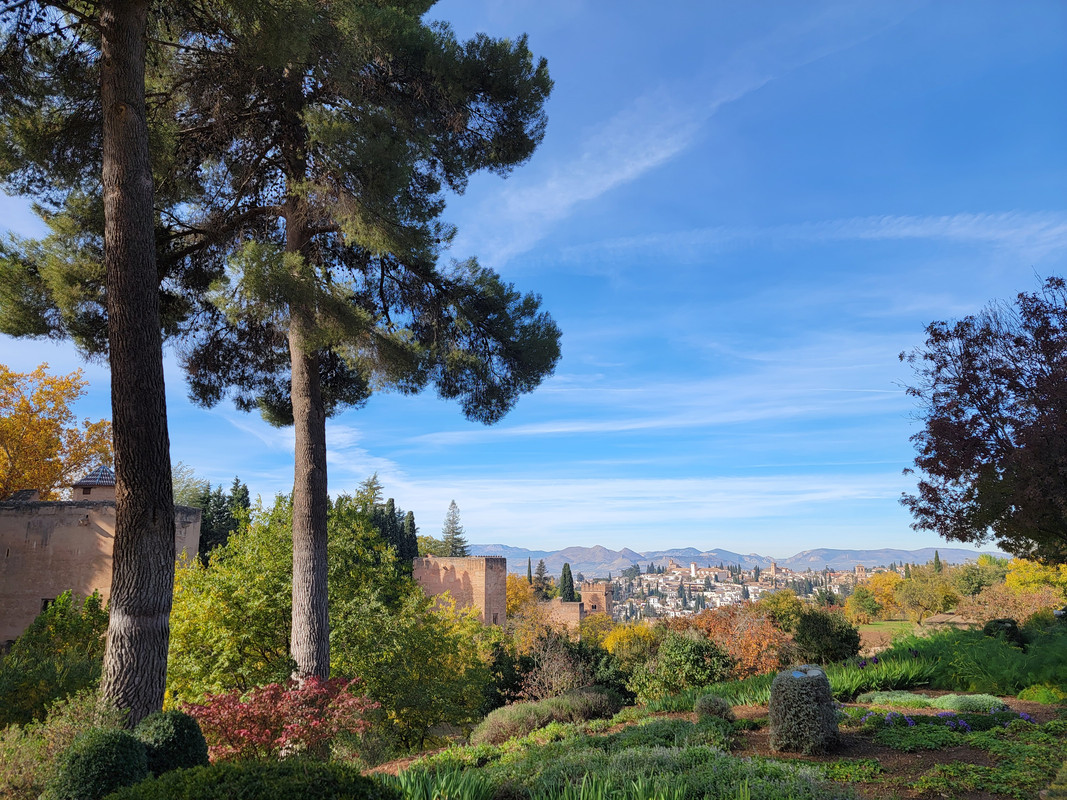

The Generalife section is comprised of beautiful, landscaped gardens, accompanied by heavenly smells.

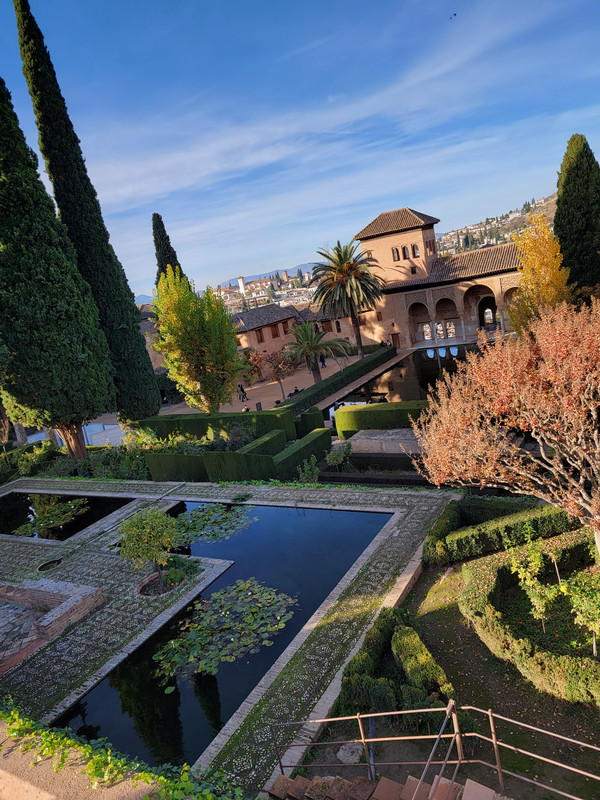
The Nasrid Palaces’ Moorish architecture with its detailed designs is incredible, although the crowds were a real downer. I had a hard time immersing myself in the beauty with all the noise and jostling.
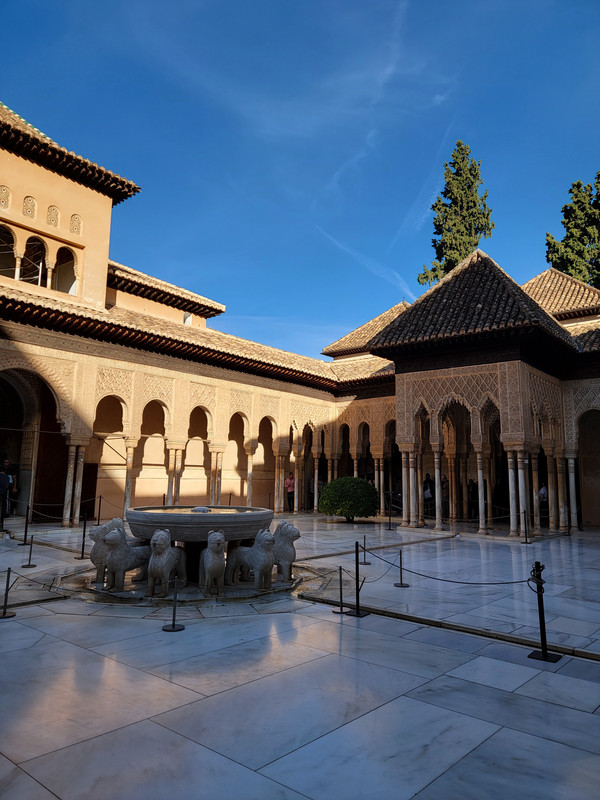
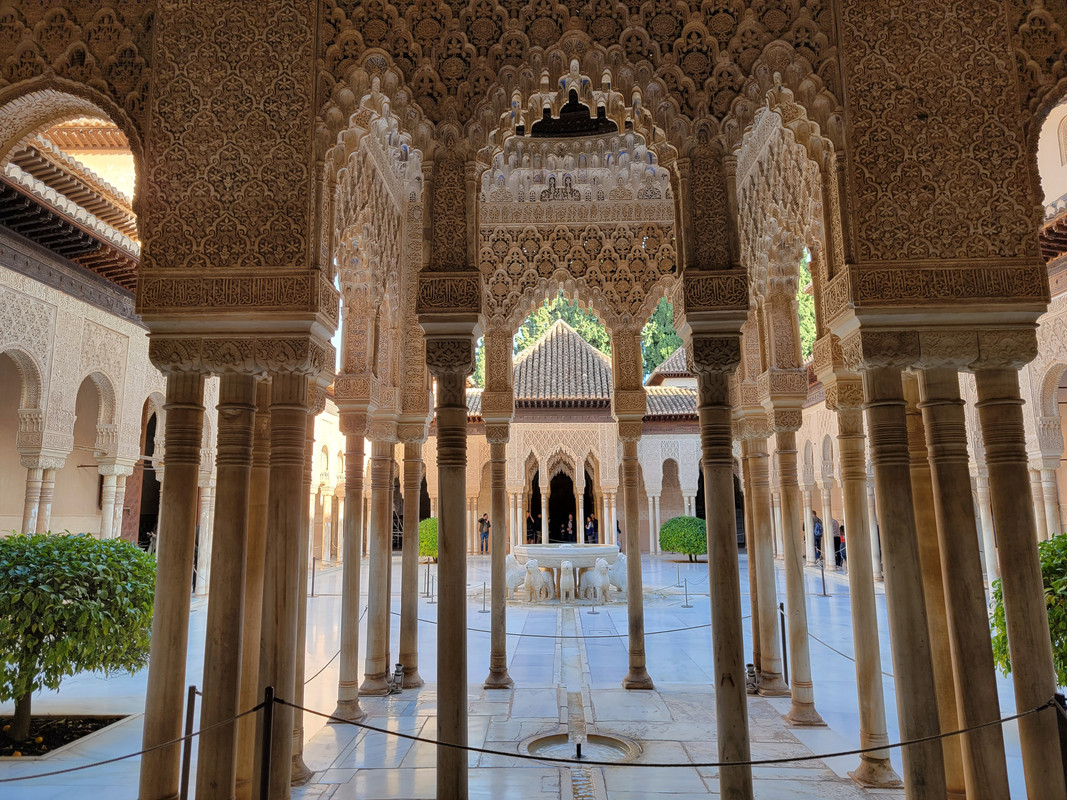
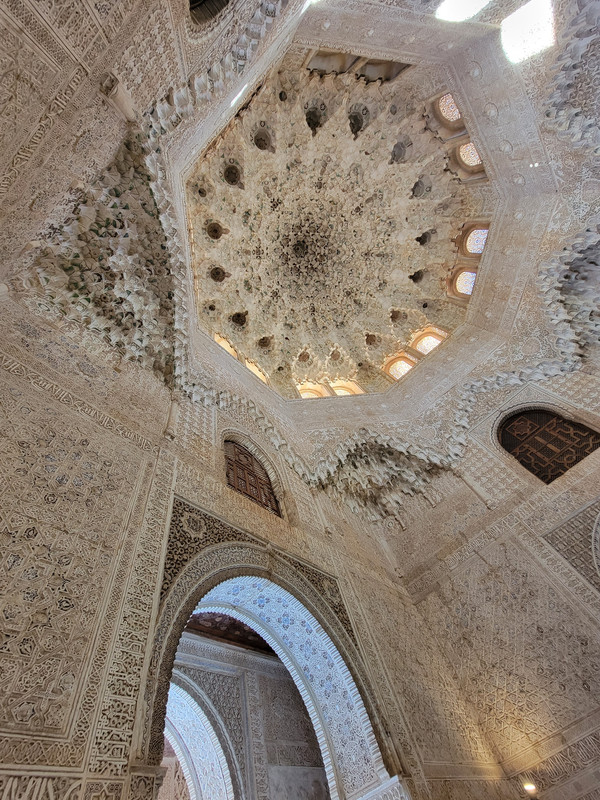
The Palace of Charles V is the most recent addition to the Alhambra- the interior, which is a gallery, appears to be unfinished.

The Alcazaba is a military fortification/castle, with sweeping views of Granada.
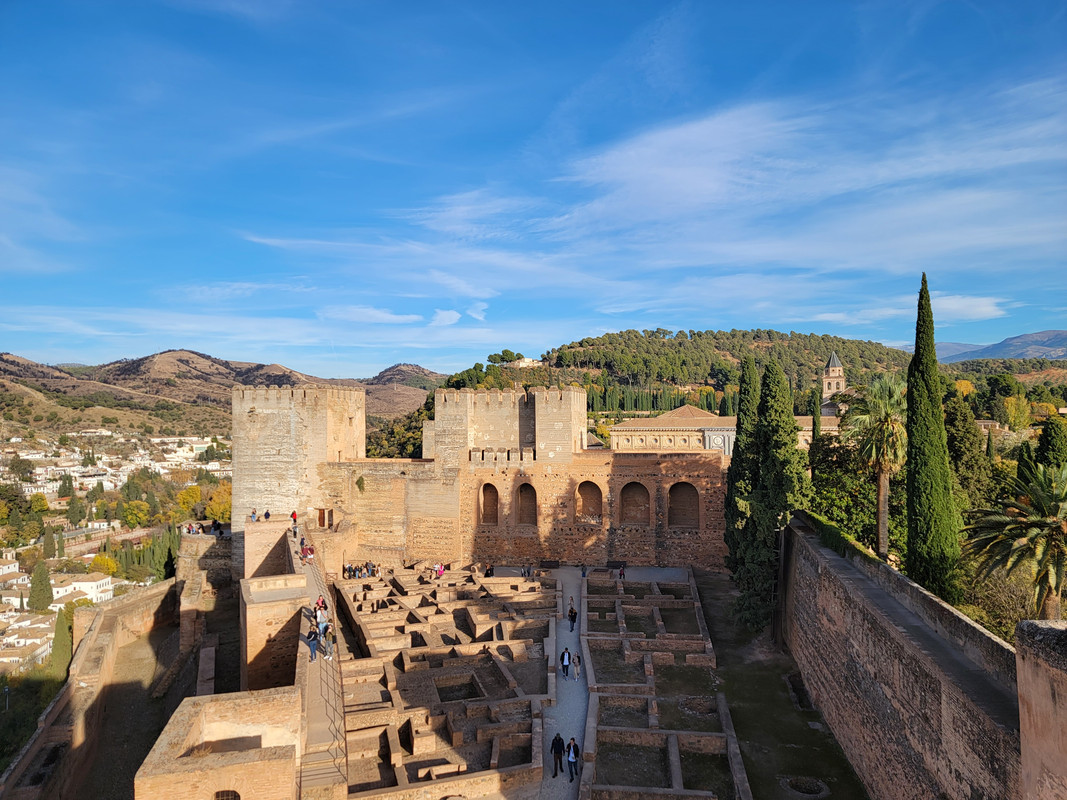
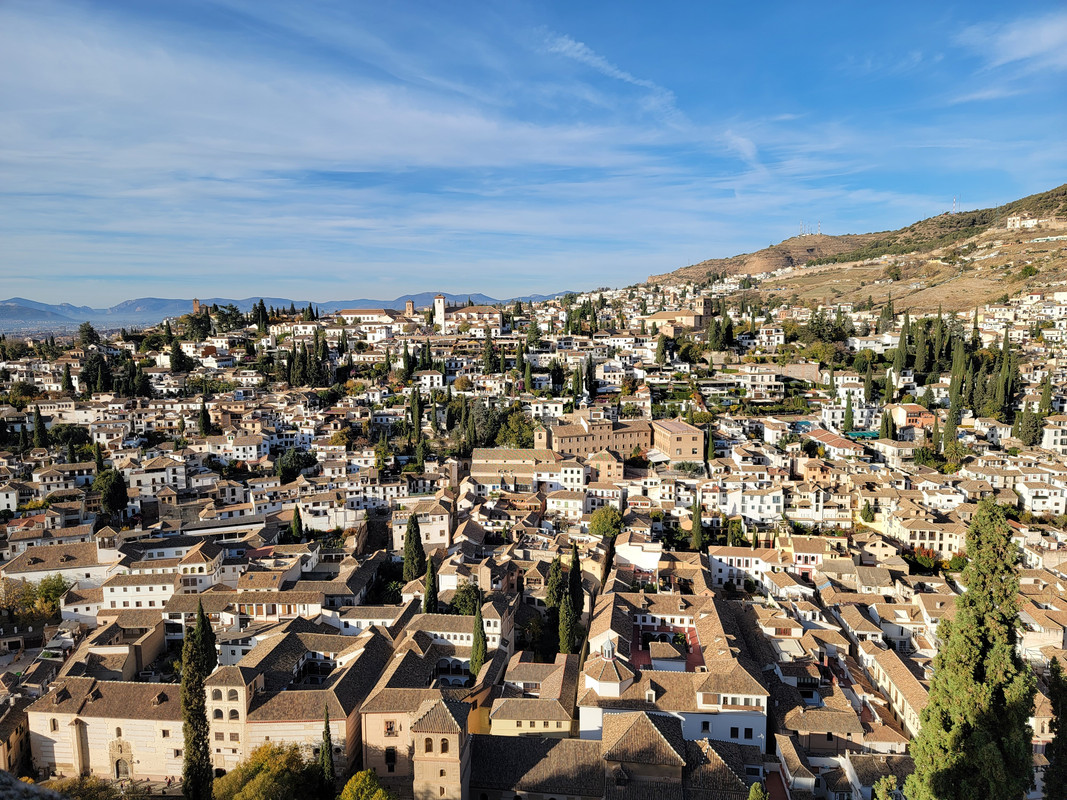
I then hiked down into the city, to Plaza Nueva de Granada.
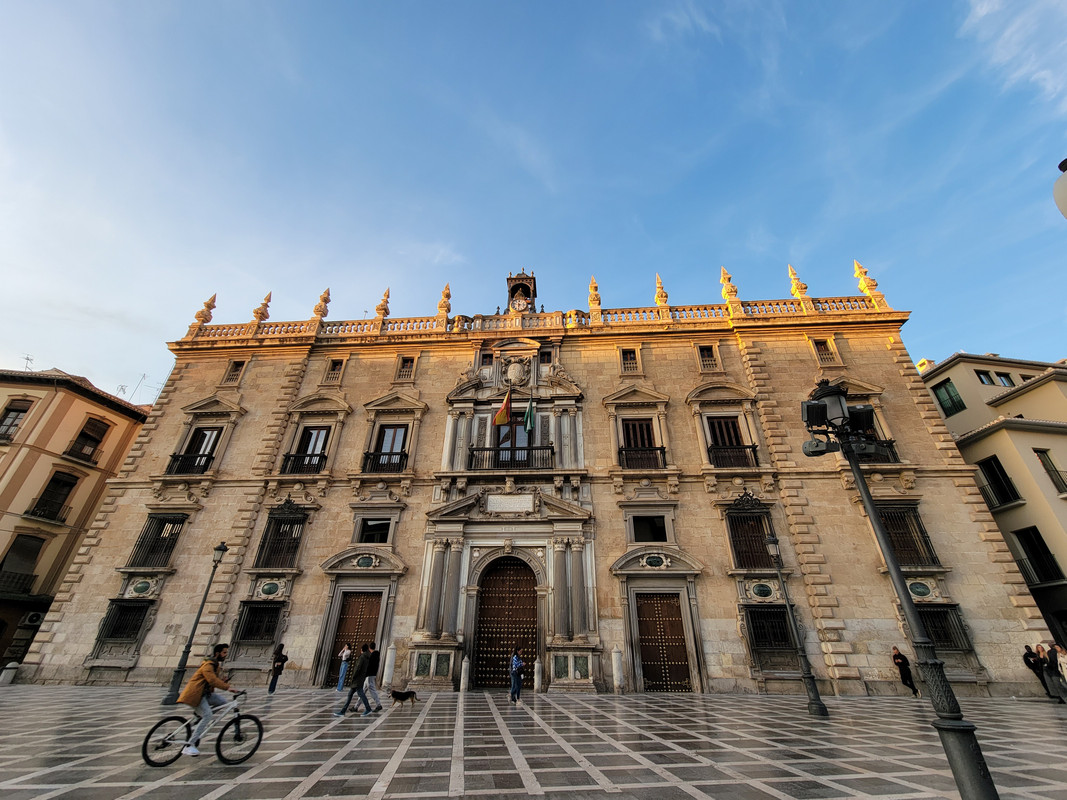
Carrera Del Darro is considered Spain's best preserved Moorish Street, and just walking around Granada is a magical experience.

Away from the main tourists haunts the streets are mostly empty.

I then dropped by the Museo Sefardí- I had reached out in advance and had not received a response, so I knew it was unlikely that they were open. There was a sign posted on the door that visits were by appointment only and can be scheduled via email at museosefardidegranada@gmail.com.

I then walked around the area that used to house the Barrio Realejo- the Jewish quarter, on and around Calle Pavaneras.

I bumped into this statue of Yehuda ibn Tibon, a physician and translator of Rabbeinu Bachya's "Chovos haLevavos" from Arabic into Hebrew.

My final stop of the day was to the Palacio de los Olvidados/Palace of the Forgotten, an exhibit on the Spanish Inquisition. While it was very interesting, some of it was too gory for me to absorb, and I skipped the more detailed explanations. Probably not suitable for younger children.
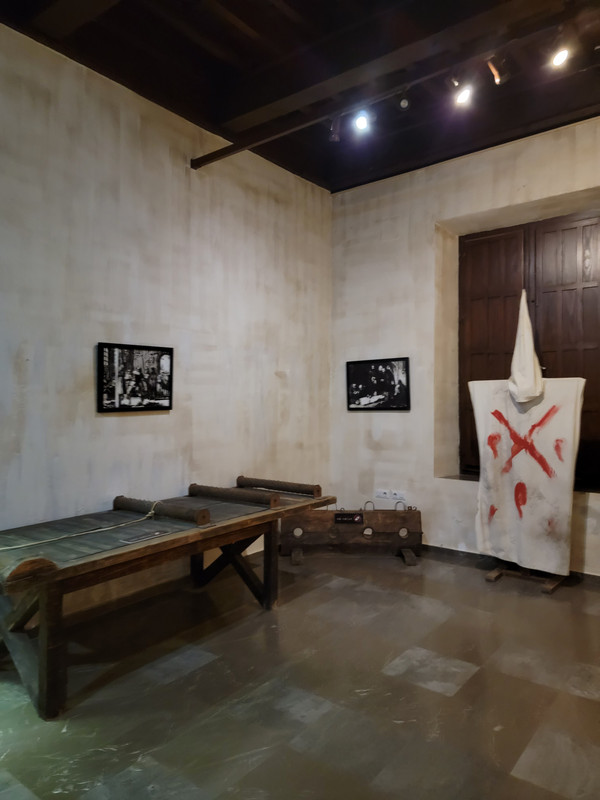

I then hiked back up the steep hill to the Alhambra parking lot to collect my car, stock up on groceries, and start the one-hour drive north to Jaen.
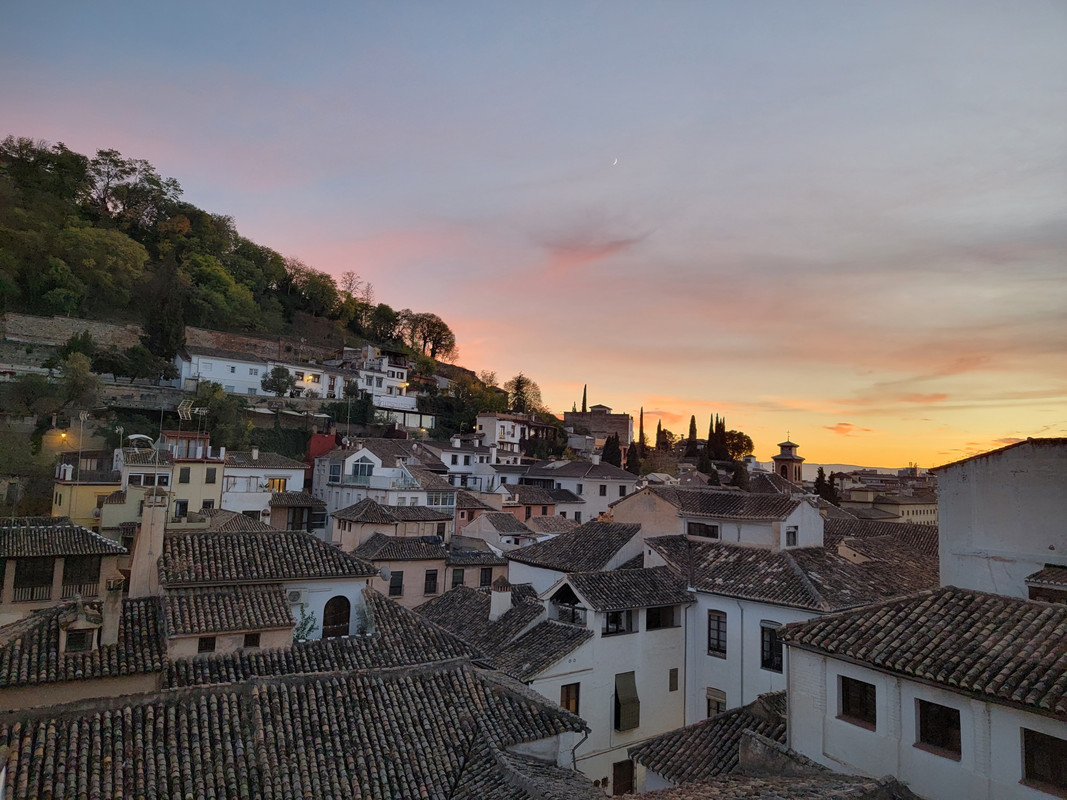
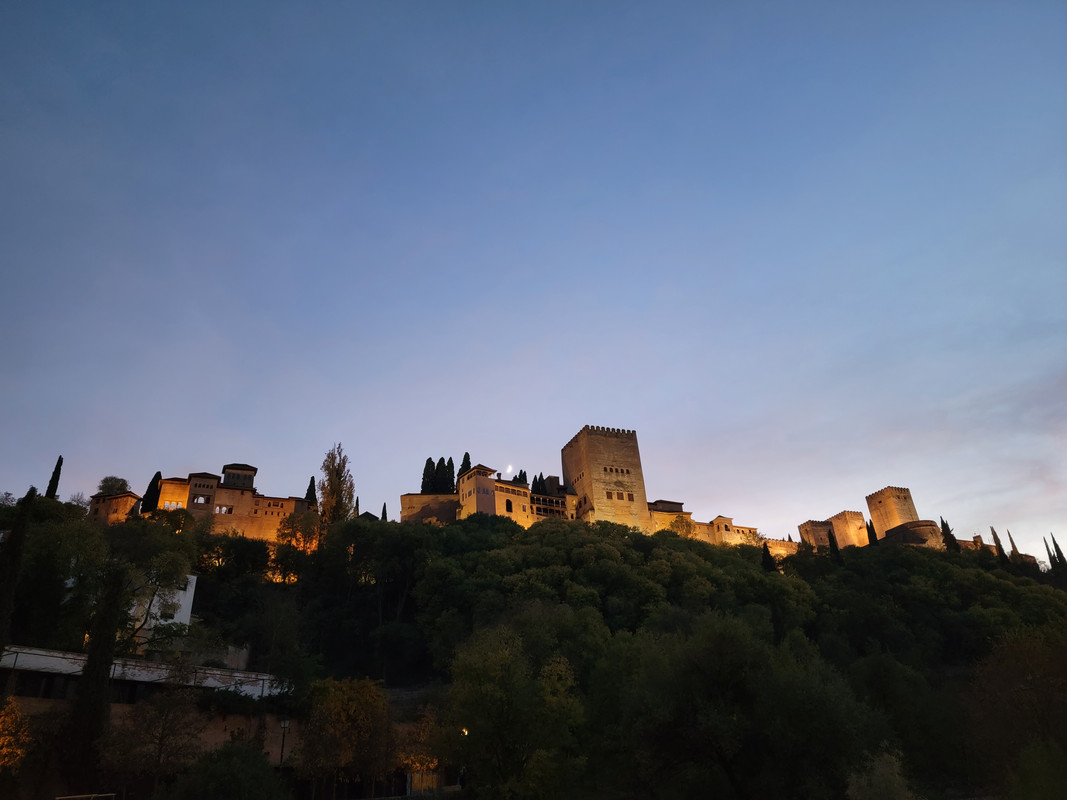 Jaen
JaenJaen is not a popular tourist destination, but from a historical Jewish perspective it holds significance as the birthplace of Chasdai ibn Shaprut, who later moved to Córdoba. He first rose to fame as the Caliph’s physician and was eventually appointed foreign minister. He was a great supporter of the Yeshivas in Sura and Pumbedisa, and redeemed Rabbi Moshe Bar Chanoch from captivity (who according to legend was one of the four scholars from the Sura Yeshiva captured by pirates in Europe). This allowed him to establish his own Yeshiva, and this is where the center of Torah starts shifting from Babylon to Spain. (I listened to this fascinating
lecture from Dr. Henry Abramson on my drive to Jaen).
I checked into Hotel Condestable Iranzo for the night. There weren’t many options to choose from in Jaen, and this was a “best of the worst” scenario. While the rooms were dated, it was clean. The biggest downside was the paper-thin walls which allowed me to hear all the comings and goings of all the hotel guests. The hotel does not have their own parking, but there’s a garage across the street, and rates were very reasonable.
Monday dawned bright and sunny, with temps in the low 50Fs. My first stop of the day was to Plaza Santa Maria, where the Court of the Inquisition of Jaen was located. Jaen’s inquisition processed the third highest number of inquisition cases (after Seville and Córdoba) which gives some indication as to the number of Jews living in this region at the time.

While I did not enter the Jaen Cathedral, the interior boasts motifs that show that many of its parishioners were originally Jewish.
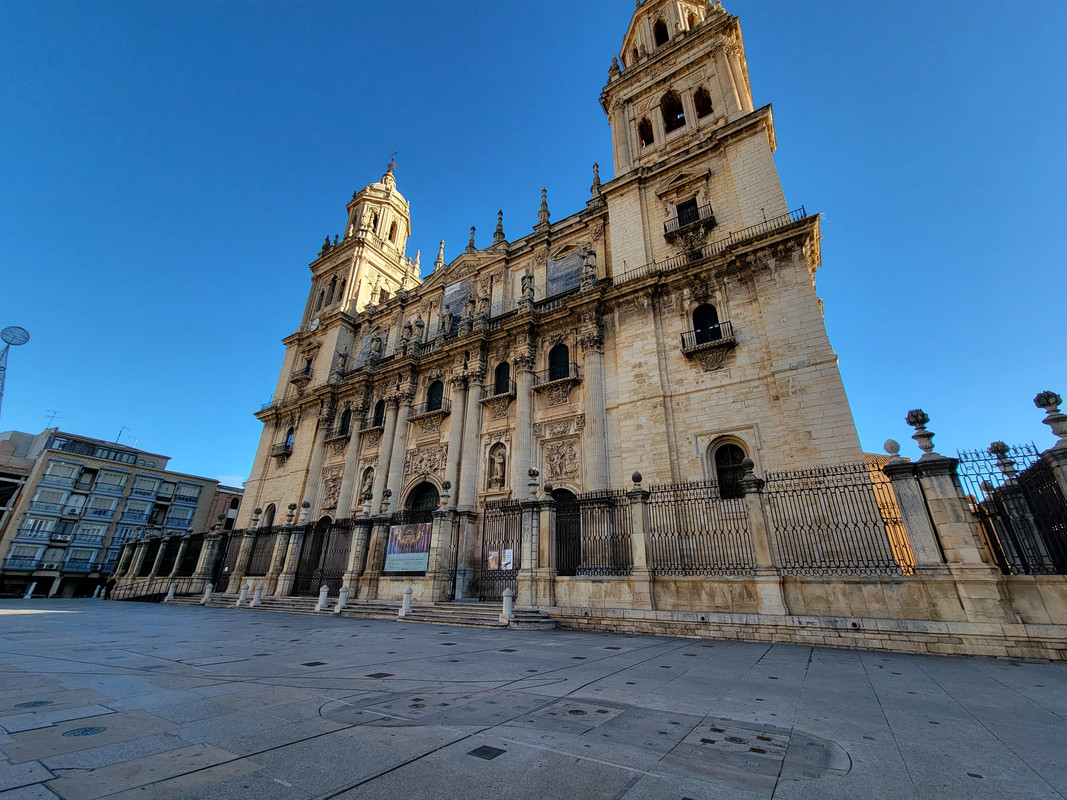
The Palacio del Condestable Iranzo, where inquisitors were housed when adjudicating cases in Jaen.

St Lorenzo’s Arch

The Real Monasterio de Santa Clara, today a convent, was the location of the medieval synagogue. It was sold to the church after the 1391 riots.

Calle los Huérfanos and surrounding streets, which used to house the Jewish quarter of Jaen.
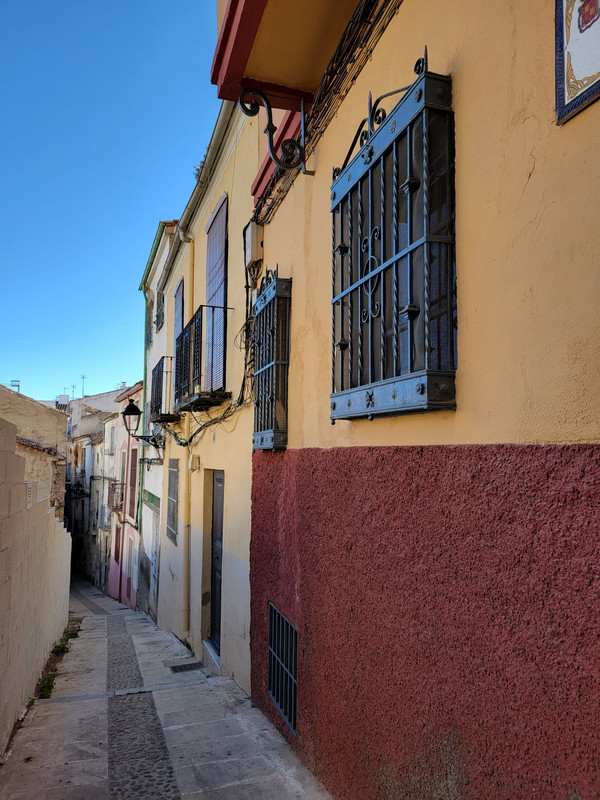
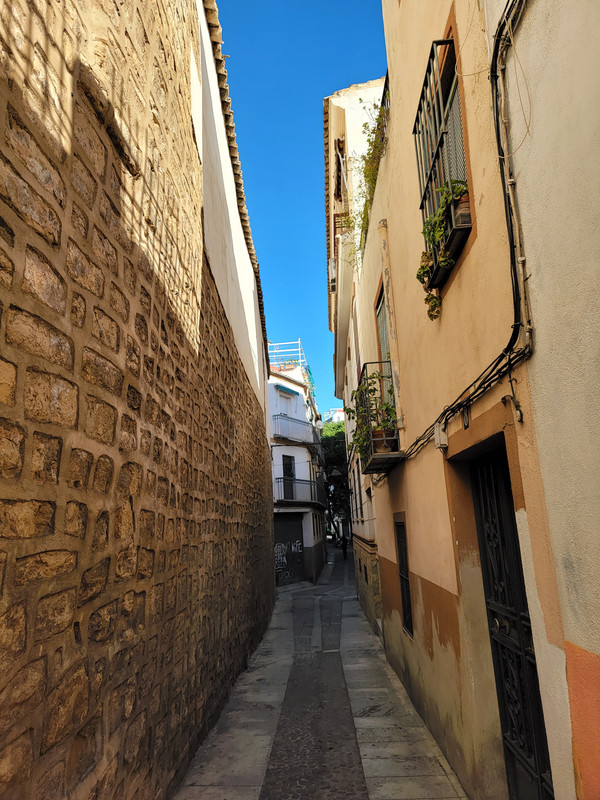
In Plaza del Dr. Blanco Najera there is a large menorah to honor what was once the Jewish quarter. There’s a memorial plaque written in both Castilian and Ladino.

A memorial to Chasdai Ibn Shaprut, who was born in Jaen.

At the entrance to the Sabetay Djaen building (part of the Municipal People’s University) there is a display case that showcases a replica of a “yad” pointer of the 14th century which was found during an archaeological dig under the building.

There is some who are of the opinion that St Andrew's Chapel was a synagogue as well, since it is not very tall or beautiful, (by law, synagogues could not be taller than churches, or ostentatious) as well as the building facing East and some other clues.

The IMEFE Central Services/ Torres de Navarra´s Palace has a tiny exhibit on the first floor of Chasdai’s life. Not much to see here.

The Convento de Santo Domingo housed various inquisition employees.
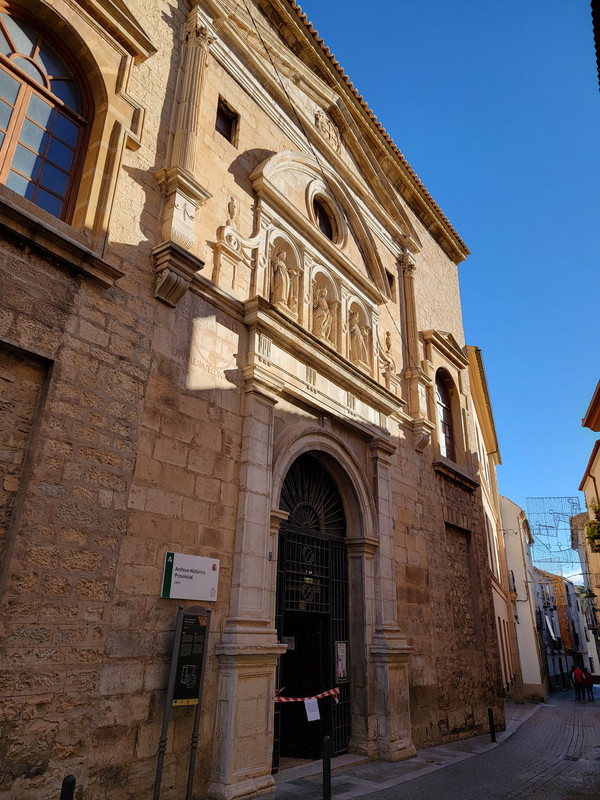
Chasdai’s house is located at Plaza de la Magdalena 6 and is noticeable by the large Star of David on the façade. The interior is not open to visitors.

I did notice quite a few houses in Jaen that have a Star of David displayed- possible that those are all houses that have been verified as previously belonging to Jews, but I’m not sure.
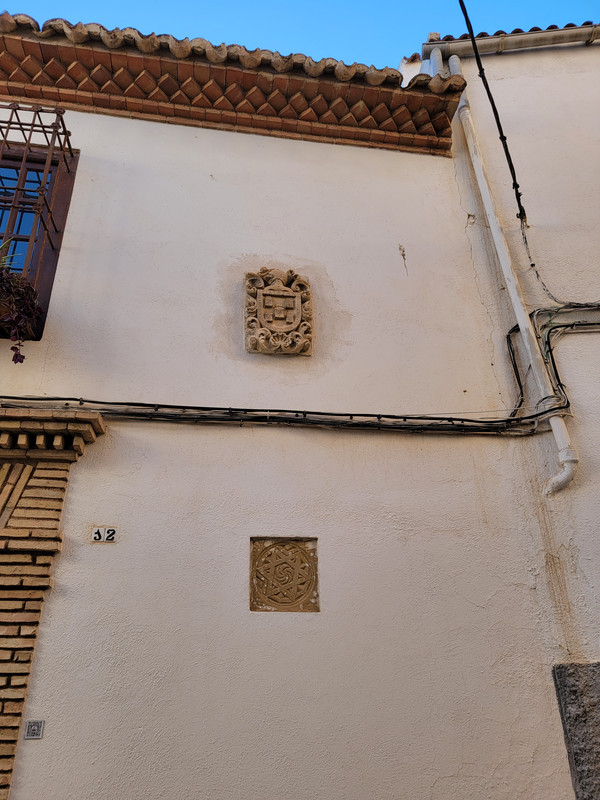
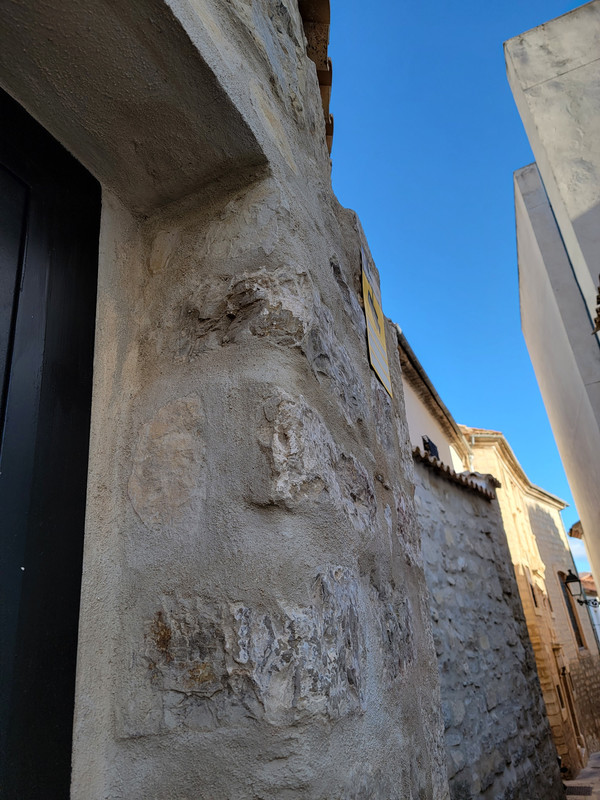
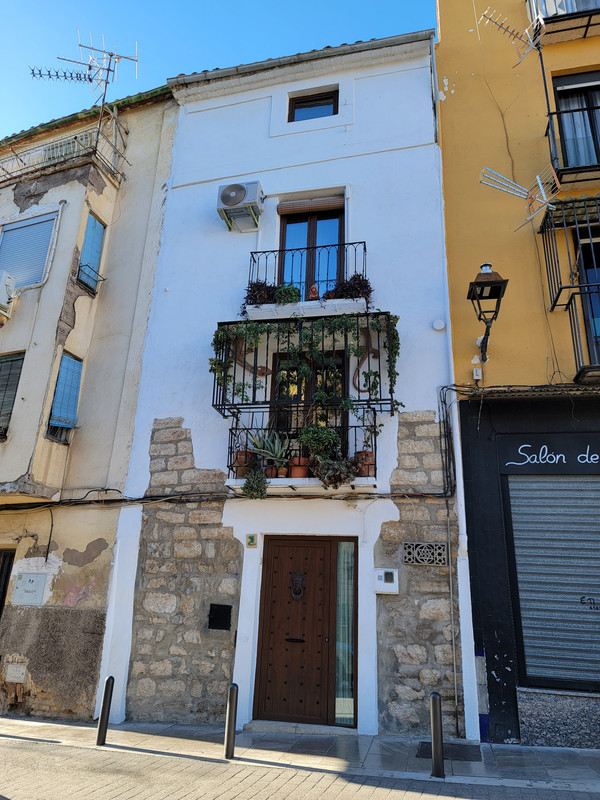
My last stop in Jaen was to the Castillo de Santa Catalina. There’s free parking up here (it’s quite a fun drive up to here from the town) with incredible views up top.
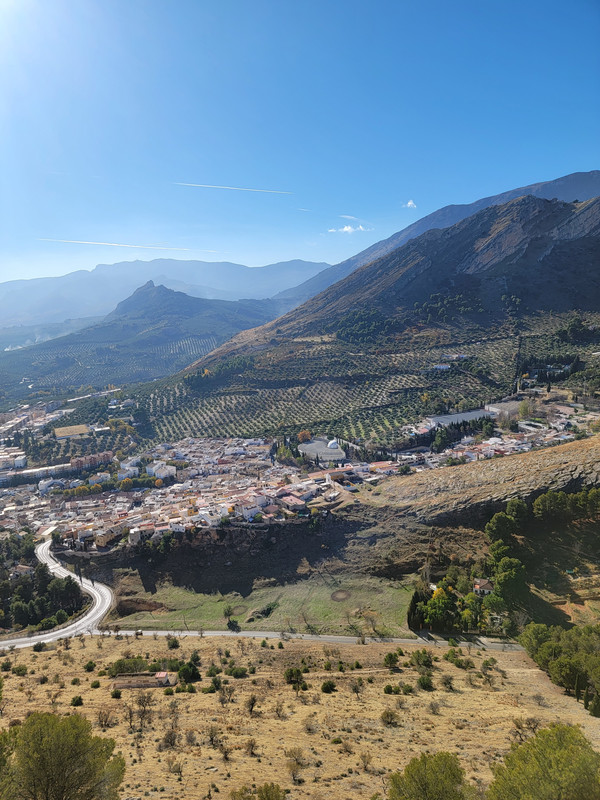
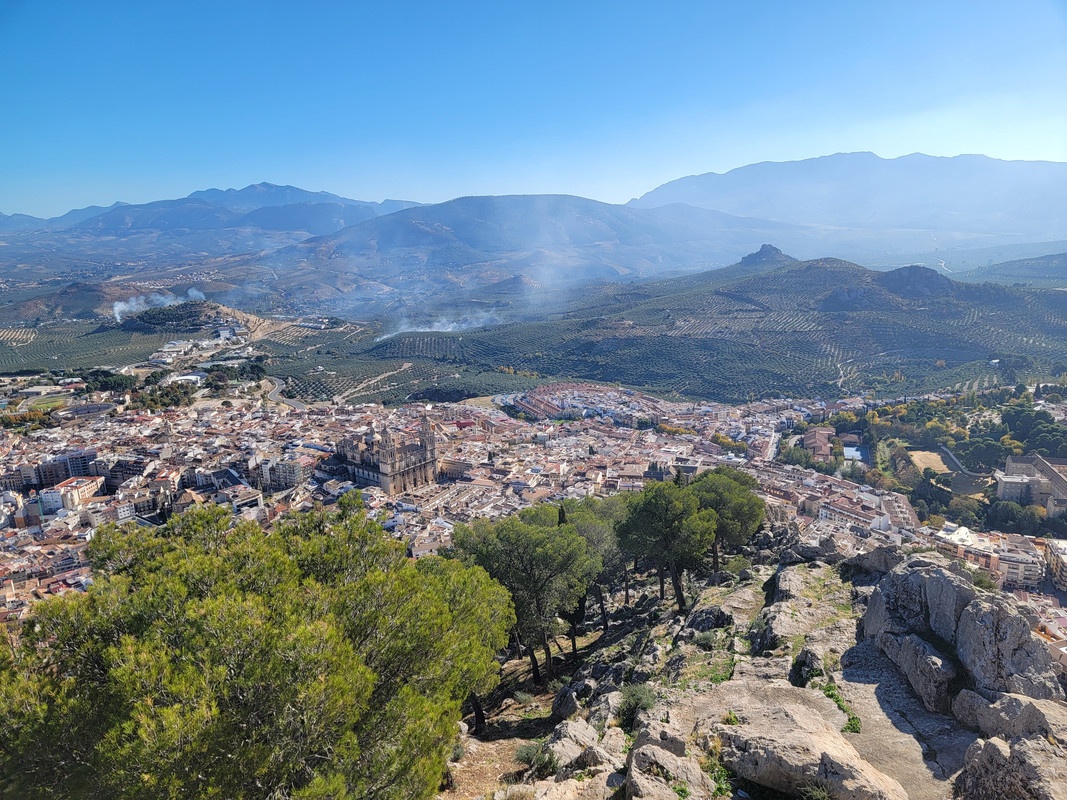
The castle itself wasn’t that interesting, but they had free entry that day, so I checked it out.
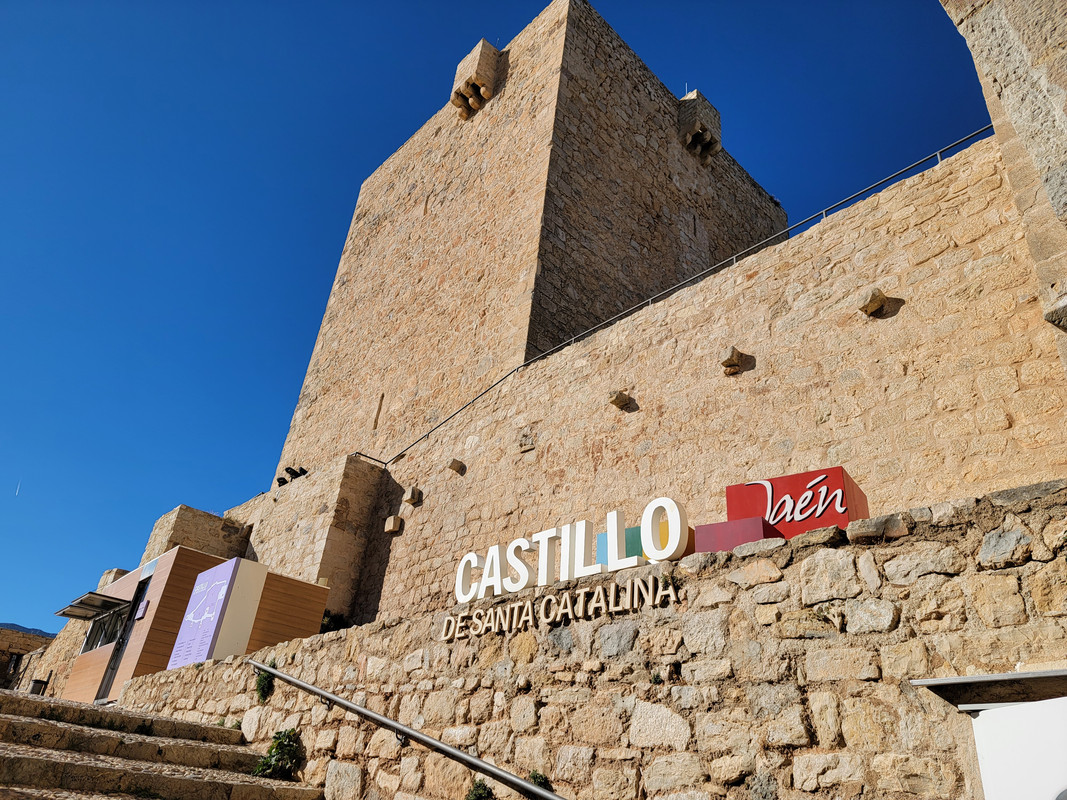
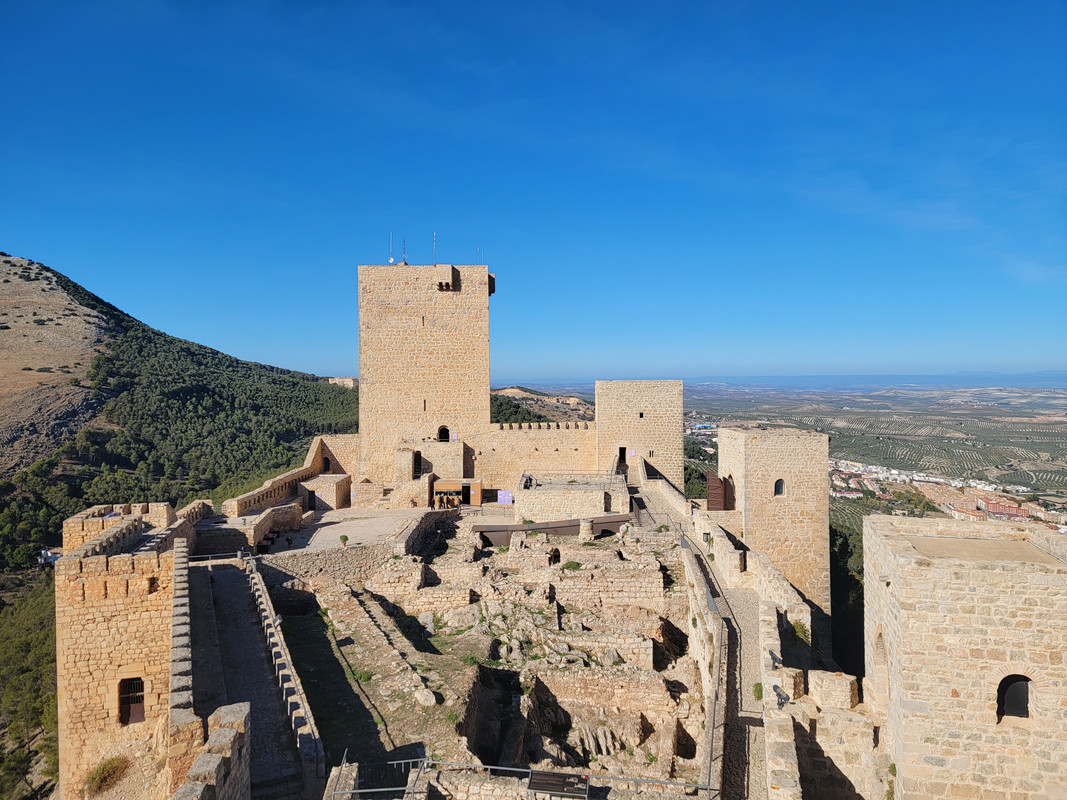
There is also a Parador (government owned luxury hotel located on historical property) here, which for some reason didn’t come up when I was originally searching for a hotel in the region. From the glimpse I got it looked really nice.
I then drove 40 minutes to the town of Úbeda.
ÚbedaThe main goal of my stop to Úbeda was to visit the Sinagoga del Agua, which is supposedly the site of a medieval synagogue and mikveh. Note that many historians scoff at this, as there is no documentary evidence to back up the fact that this was indeed a synagogue, although I found the anecdotal evidence compelling (keeping in mind that there is a possibility that this is all a hoax to draw tourists to Úbeda).
I parked at the municipal Redonda de Miradores Park, where parking is free.
The town’s main square, Plaza de Sta Lucia.

Casas Judías Úbeda was once the residence of a Jewish family- it’s been defaced and there’s nothing to see here.

Plaza 1º de Mayo was the site where the inquisition performed the auto-da-fé in Úbeda.

Advance reservations are required at the Sinagoga del Agua via
http://sinagogadelagua.com/en/home-2/. There is a requirement of at least two reservations per booking, so I paid for one adult and one child to meet that requirement. I was not aware that the tour would be entirely in Spanish, which prevented me from understanding half of the details and from asking too many questions. They have a pamphlet available in English, and while my tour guide spoke English, he did not translate more than a few sentences for me. The Spanish tour seemed fascinating though, based on the little I understood and the groups’ reactions.
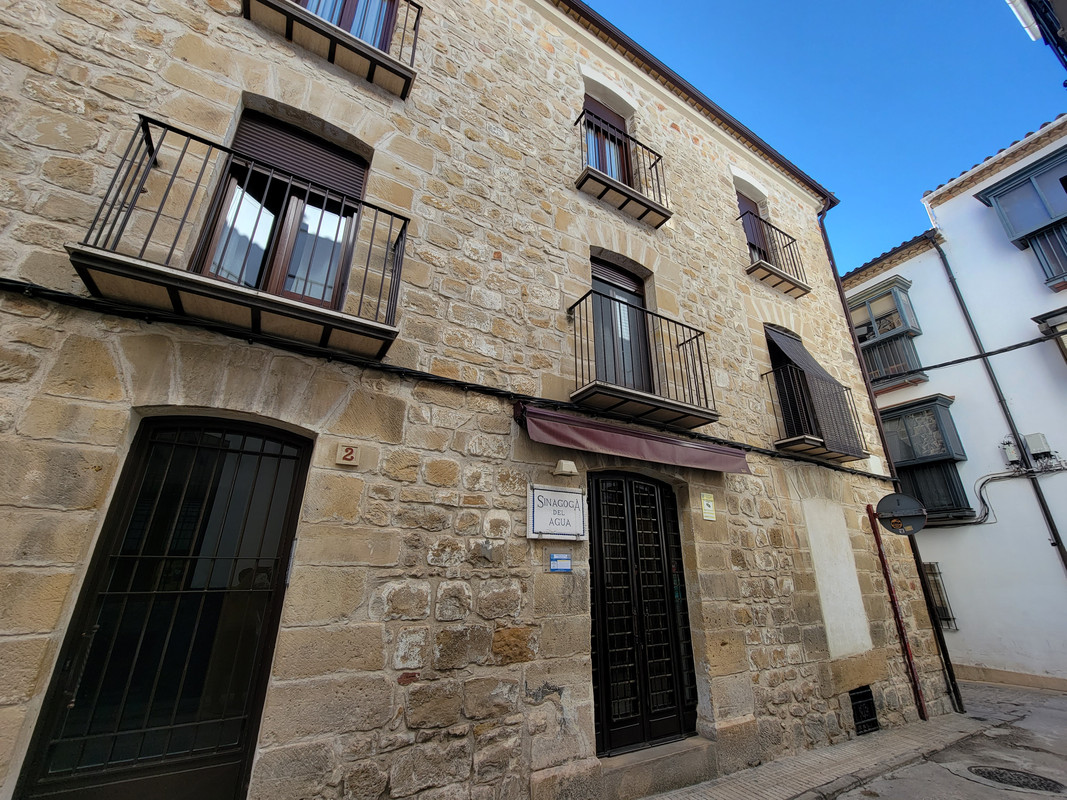

The short history of the synagogues is as follows: In 2007 a developer looking to build new apartments started demolishing some structures and came across what he believes to be the location of the Úbeda shul. His evidence is made up of the following:
The women's gallery

A Genizah urn (the urn opens to a large pit in the ground, and many Hebrew fragments were found buried here)

A purported Mikvah located in the basement.

The house of the inquisitor at Calle las Parras 8

Gate of Granada

Plaza de Vázquez Molina
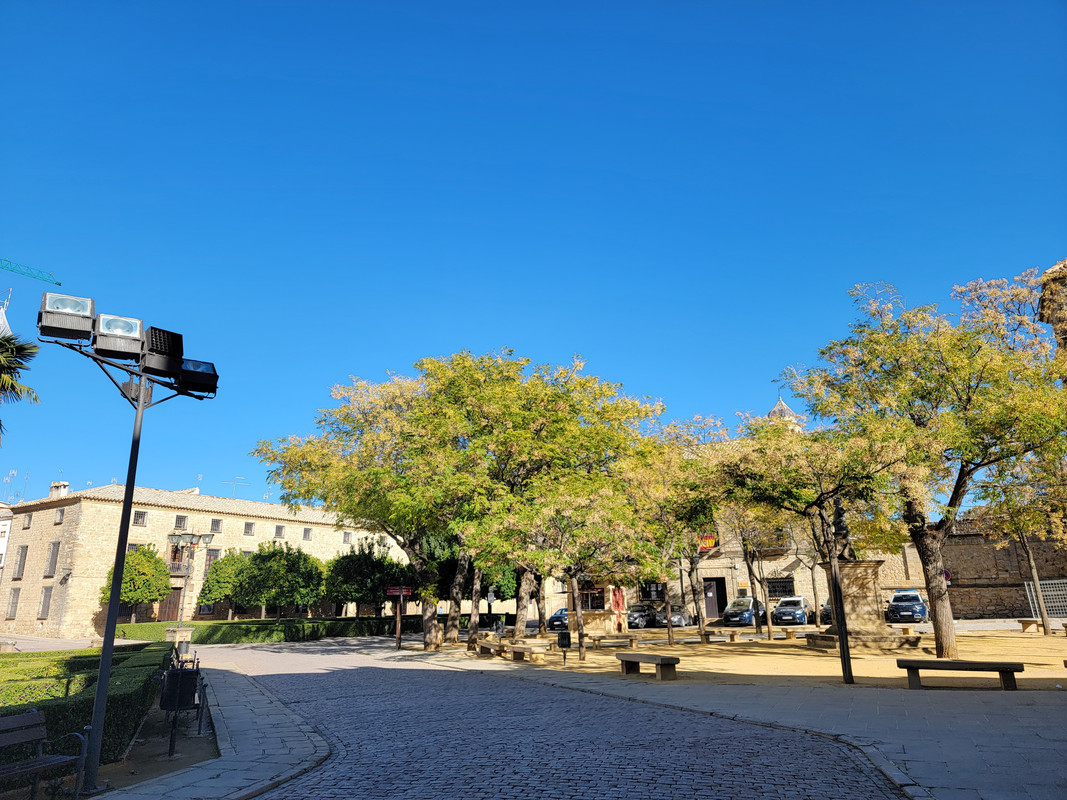
On Calle Juego de Bolas, which used to house the old Jewish quarter, there are supposed to be two houses where a Star of David is visibly engraved on the lintel. I was unable to locate it- perhaps it’s been painted over recently?
My final stop in Úbeda was at the Mirador del Alcázar overlook.

I then headed out to Córdoba, a drive that took an hour and 45 minutes. I noticed on the drive that Spain’s DOT had come up with a brilliant and novel way to deal with potholes. Instead of fixing it, just lower the speed limit! The speed limit would drop from 120kmh to 70kmh with no warning, the road would be in terrible shape, and then once it was back to steady ground, the speed limit was restored to 120kmh. Bizarre.
CórdobaPre-Rishonim: Chasdai Ibn Shaprut, Rabbi Moshe bar ChanochFamed Córdoba Rishonim: Rabbi Moshe ben Maimon (Rambam, Maimonides) as well as R’ Yehuda Halevi, author of the Kuzari, who passed through here on his travels.Visiting Córdoba was definitely one of the highlights of this trip. It’s a beautiful medieval city and I highly recommend setting aside time to just wander around. I purposely took longer walking routes because rambling along the streets was such joy.

The weather was a perfect 60F and sunny during the day (although it did drop down to the high 30Fs at night).
The streets away from the main haunts were quiet and not crowded with tourists.

All over town there are woman trying to coerce tourists to purchase rosemary leaves, and they get quite pushy at times. Just ignore them.
The city is full of orange trees, which adds a certain artistic vibe.

During my research for kosher food in Spain I came across a restaurant in Córdoba, Casa Mazel (
https://casamazal.es/carta-kosher/), which advertises that they offer kosher meals. I reached out to them to inquire, and they informed me that it’s prewrapped meals that they can warm up with advance notice, under the supervision of the SKS out of Marbella (
http://www.spainkosherservices.com/). I asked around and was unable to find more information on the hechsher, so I did not end up ordering meals here.
I checked into the Eurostars Azahar hotel for the night, again taking advantage of a 10% Eurostar loyalty coupon. The room was great, although the shower wasn’t fun as the water came in hot and cold bursts with no advance warning. The hotel does not have parking on site, but they offered a discounted rate at Córdoba Parking SA. Note that most of Córdoba is a pedestrian only zone, so I had to register my plate with the hotel to prevent any parking/driving violations. There was still some daylight left, so I spent about an hour ambling around Córdoba.
The Rambam statue (if you look closely, you’ll notice that the beard, book, and shoes are discolored. That’s because locals touch these three spots when passing through. I’m not sure what the significance is).
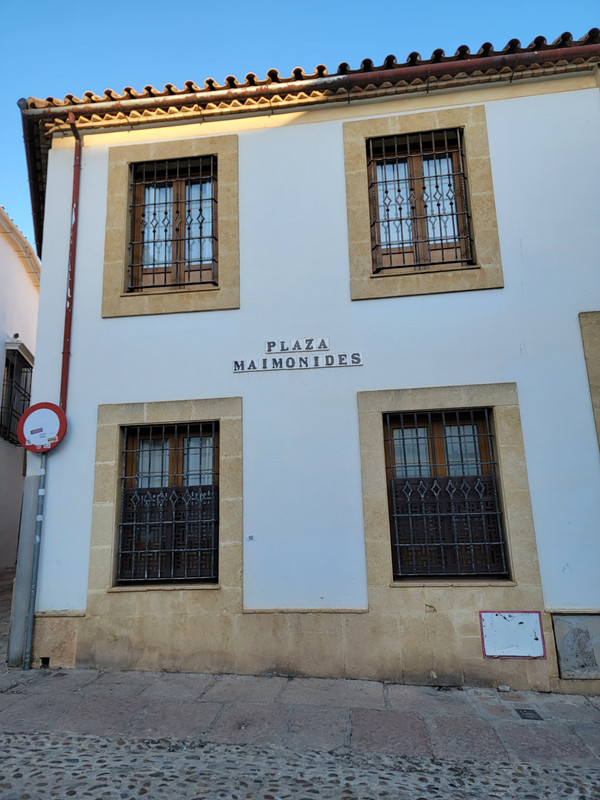
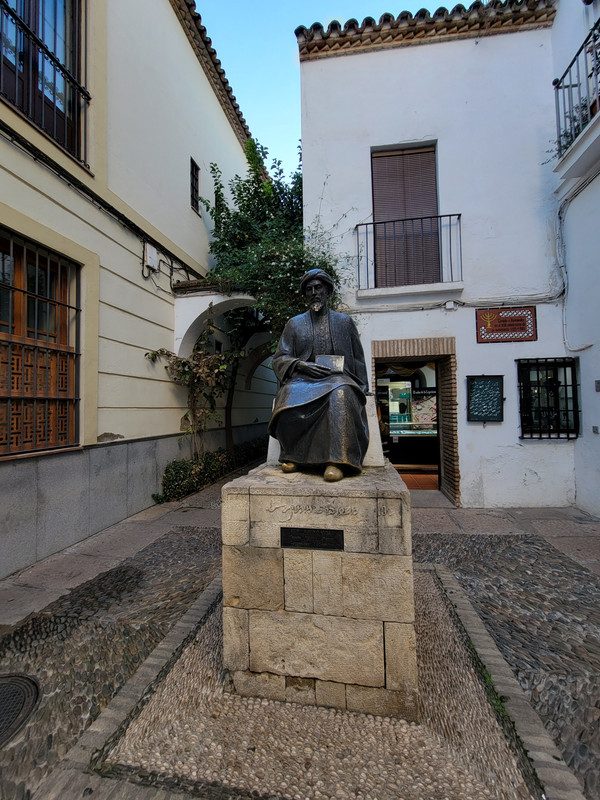
Pl. de Judá Levi
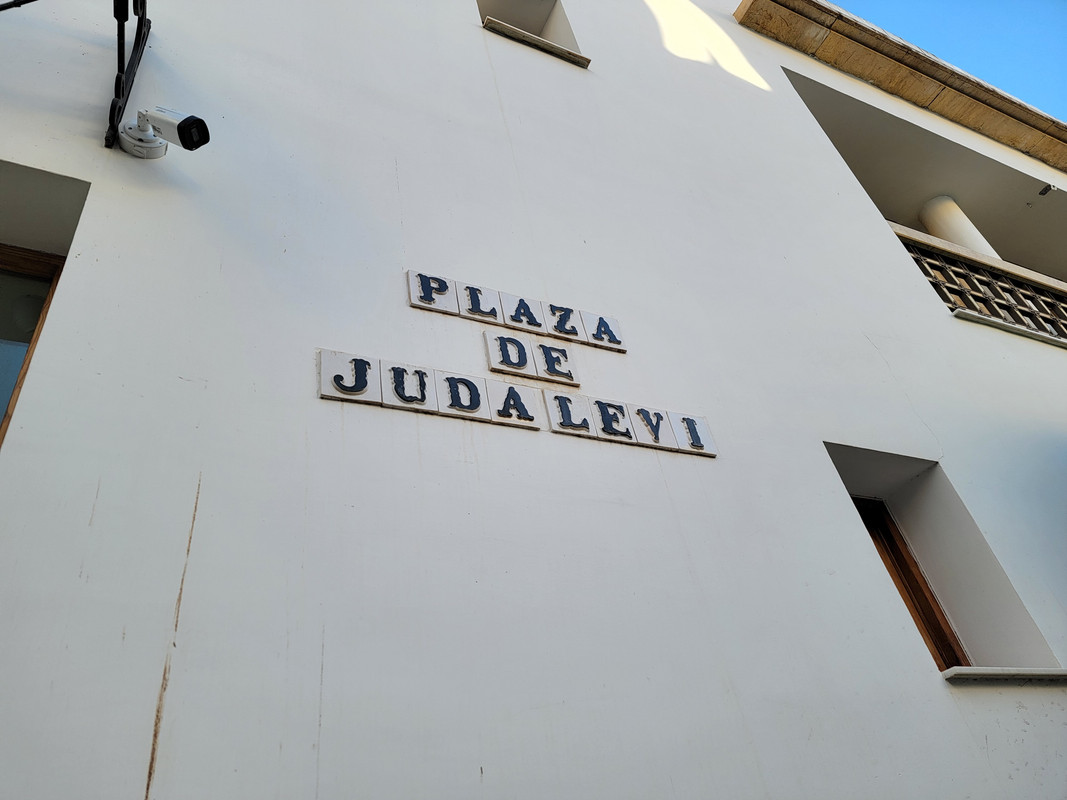
The Mezquita, which has housed both a mosque and a cathedral. I just walked around the courtyard here.

Roman Bridge of Córdoba

I then headed to the Torre De Calahorra, which is a tower located at the end of the Roman Bridge, that houses the Córdoba history museum. They reiterate over and over that when Córdoba was the capital of Al Andalus (Muslim Spain) in the 10th and 11th centuries, it was considered one of the most advanced cities in the world, and that Muslims, Christians, and Jews coexisted peacefully in Córdoba in ways not seen before or since. Sure sounds like paradise… I finished up my visit here just as the sun was setting, and the views from atop the tower lookout were spectacular.

My last stop of the day was at the Cruz del Rastro park, which is along the river facing Córdoba. This park commemorates the attack on the Jewish quarter of Córdoba that occurred in 1473.

My first stop on Tuesday was to the magnificent Alcazar de los Reyes Cristianos.
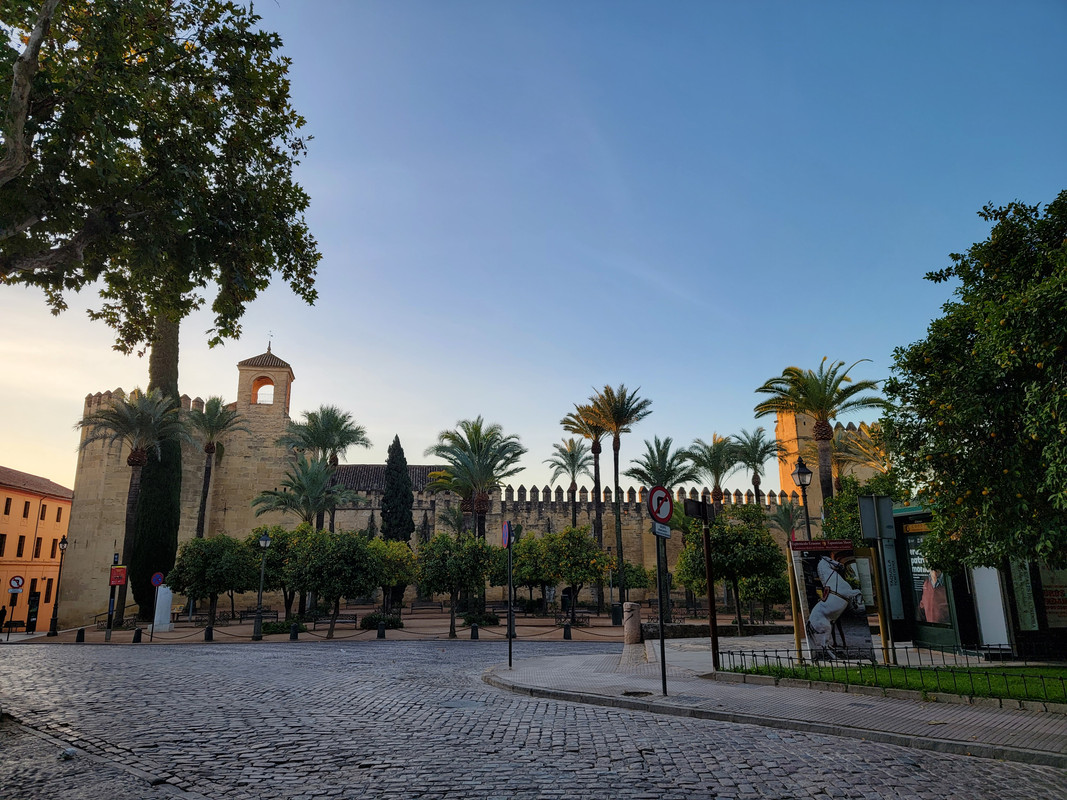
This castle/palace was built in the 14th century on the site of previous Moorish palaces, and while the interior is just an old drafty castle, the gardens are beautiful.

The Alcazar has a rather dark history, as it was donated by Ferdinand and Isabella to the inquisition in 1482, and served as the seat of the Inquisition Tribunal- the first auto-da-fé in Córdoba was held in 1483, and in 1504 107 people were burnt to death during one of the largest auto-da-fés.

I had reserved Alcazar tickets for 8:45AM in advance (they include all day entry to the Baths of the Caliphal Alcazar as well) and it couldn’t have worked out better. Tickets often sell out, and the crowds start piling in after 9AM, so I got to have the place to myself for a bit. I spent about 45 minutes here.

The castle turrets are accessible as well and offer beautiful views of the gardens and the city.

I then headed to the Baths of the Caliphal Alcazar, which is located across the street.

Next, I headed to the Judería de Córdoba, to explore some of its Jewish history.
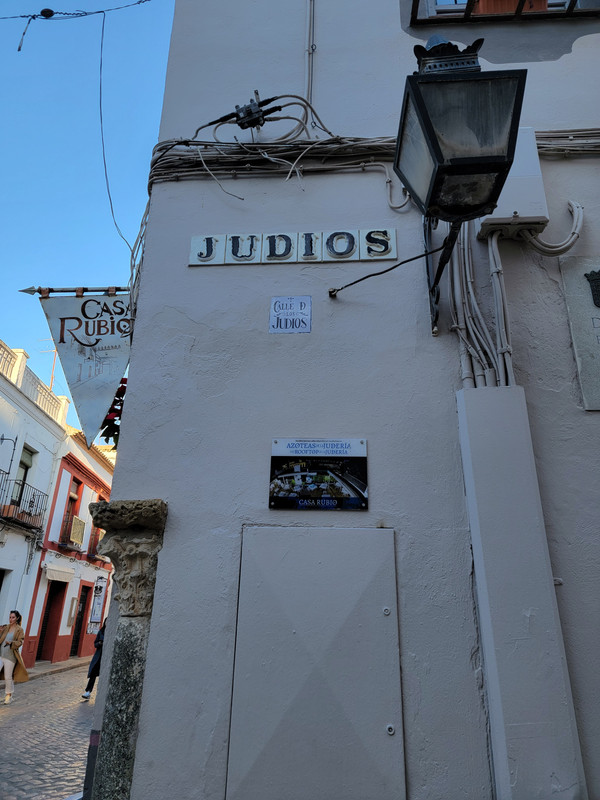
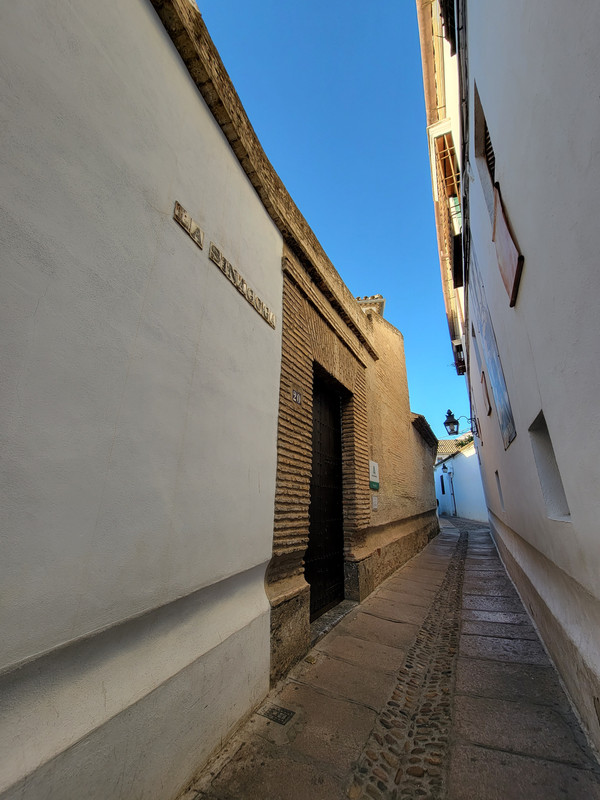
The Córdoba Synagogue, which was built in 1315, is the only synagogue in Spain from that era that was not turned into a Christian place of worship at some point. This is one of the only three shuls in Spain that have been verified by documentary evidence to have indeed housed a shul (the other two are in Toledo). A mikvah has recently been discovered on the premises as well, but it is not yet open to visitors.
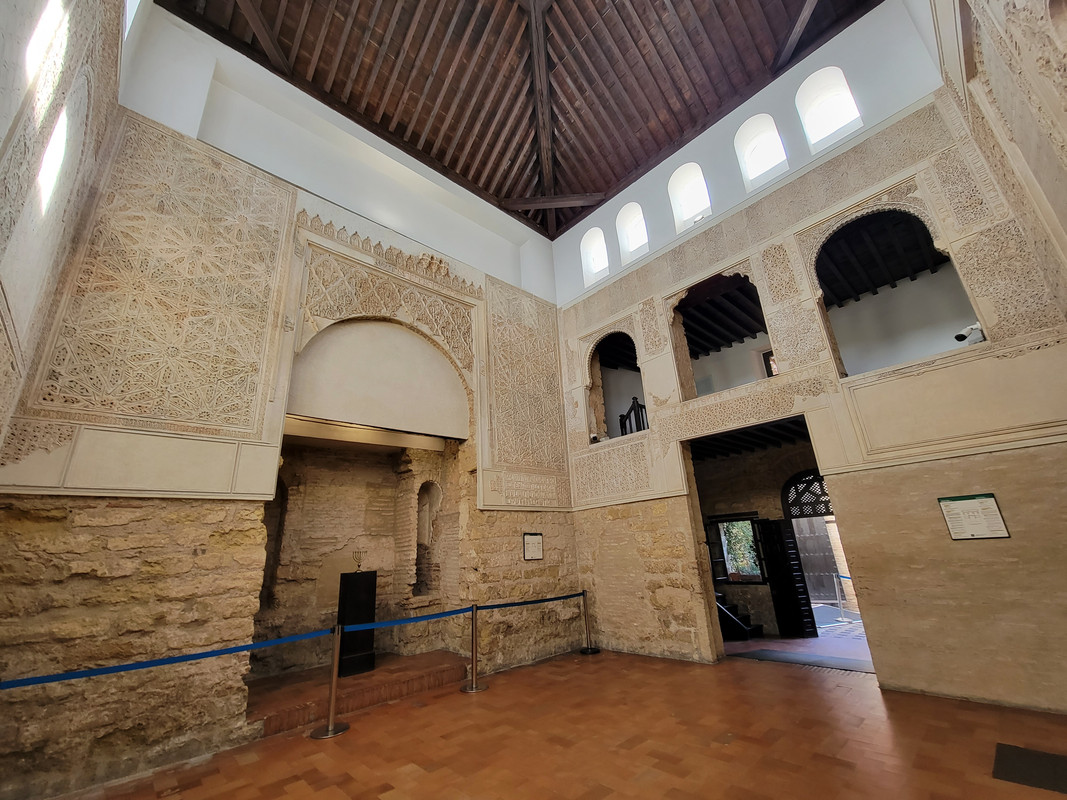
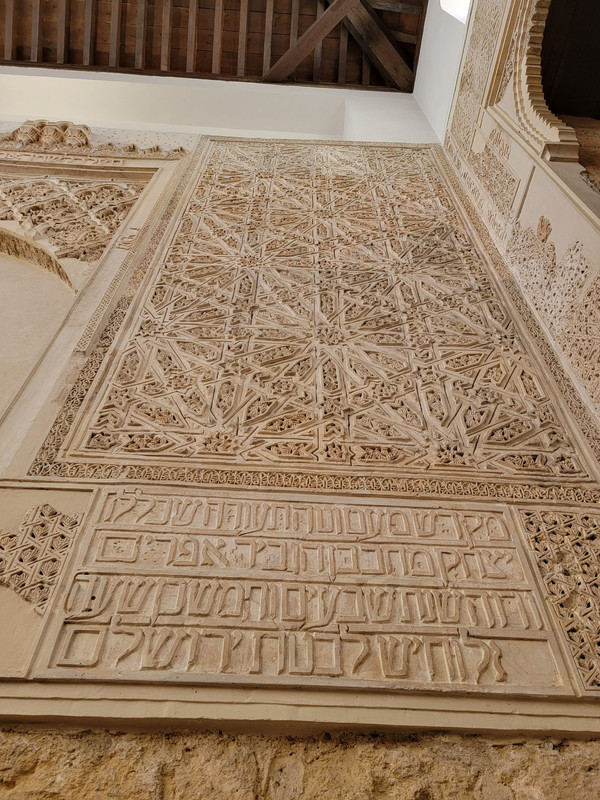
The Almodovar Gate or ‘Gate of the Jews’
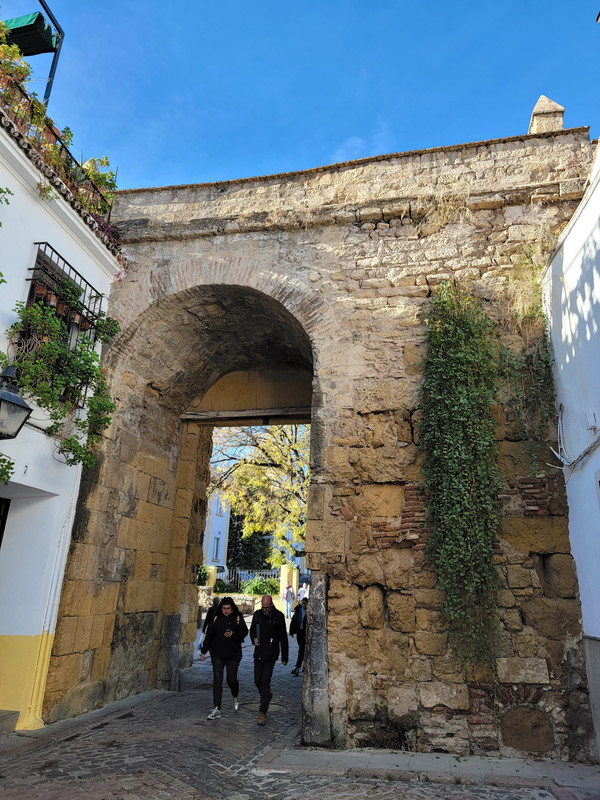
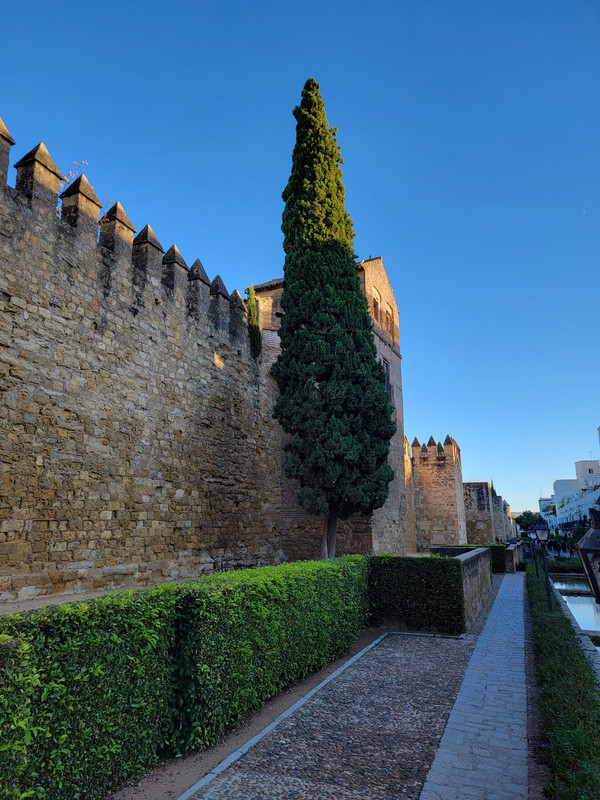
Calleja de las Flores- flower street

The Casa de Sefarad is a small but interesting history museum on Córdoba Jews. The museum is housed in a building dating to the 1300s.

I then headed to Córdoba’s Archaeological Museum. They generally charge an entrance fee to non-EU citizens, but they allowed me to enter free of charge.

There are two Jewish headstones on display here, one of Yahuda bar Akon who died in 846CE

and the other of Rabi Amicos who died in the 12th century.

There’s also some Judaic-themed jewelry that was discovered in the region on display.

Unfortunately these two tombstones, some minor artifacts, and the shul are all that remains of Córdoba’s once vibrant Jewish community.
Plaza de las Tendillas

Templo Romano
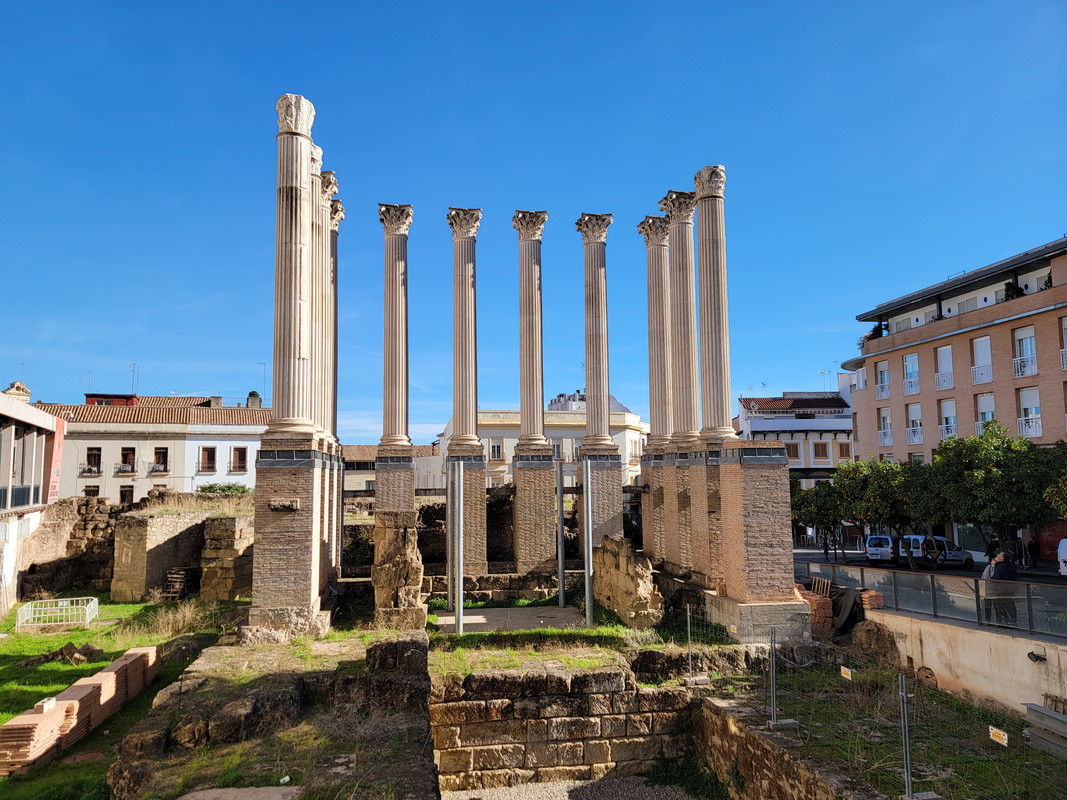

Plaza de la Corredera
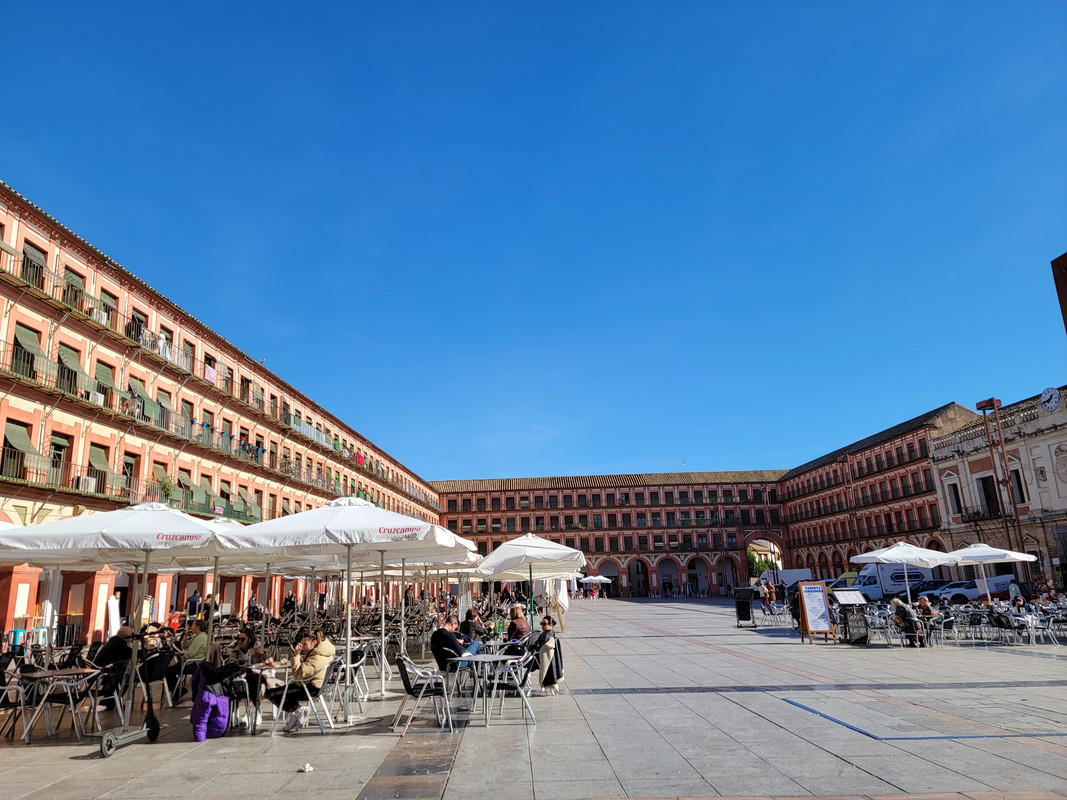
I then drove 20 minutes out of town to the Medina Azahara Conjunto archeological site. This place is a gem for anyone interested in Al Andalus history. It has an interesting museum on site, and I found the archeological site to be fascinating. Although the official website recommends spending three hours here, I managed to cover it all in two hours without rushing.

The city was built by Abd al Rahman III in 936, with the intention that it would be a royal city on the outskirts of Córdoba. It didn’t last long as various civil wars broke out.

After this I headed to the city of Lucena, approximately an hour from Córdoba. I was running low on gas and noticed that very few of Spain’s gas stations operate for 24 hours. Most of them do not have self-pay pumps, so once the convenience store closes, there is no way to activate the pump.
LucenaFamed Lucena Rishonim: Rabbi Yitzchak ibn Ghiyat, Rabbi Yitzchak Alfasi (Rif), Rabbi Yosef ibn Migash (Ri Migash), Abraham Ibn Daud. The Ibn Ezra and R' Yehuda HaLevi both spent time in Lucena as well.The town of Lucena boasts a fascinating Jewish history- according to legend the reason why it has no Jewish Quarter is because the town was inhabited entirely by Jews from 9th to the 12th century. There are many Gaonic letters between the Yeshiva in Sura and Lucena dating to the 9th century- Lucena’s Jews are mentioned as being the richest in all of Spain. Most of the city was destroyed in 1148 when the Jews refused to convert to Islam under orders of the local Muslim ruler, and the community was transplanted to Toledo.
I arrived in Lucena late in the evening and checked into the Doña Lola Alojamientos Boutique hotel for the night. The staff here was helpful with my various requests such as a mini fridge for my food and detergent for the hotel’s washing machine, and the room was clean. The only downside was that the hot water lasted for less than two minutes. The parking garage located in Lucena’s main square, near the hotel, offers discounted rates of €8 when showing the hotel’s booking confirmation.
After checking in I headed to the Municipal Public Library, which used to house an exhibit on Lucena’s Jewish history, but that has since been terminated. The street signs are displayed in Hebrew as a remembrance to the town’s history.
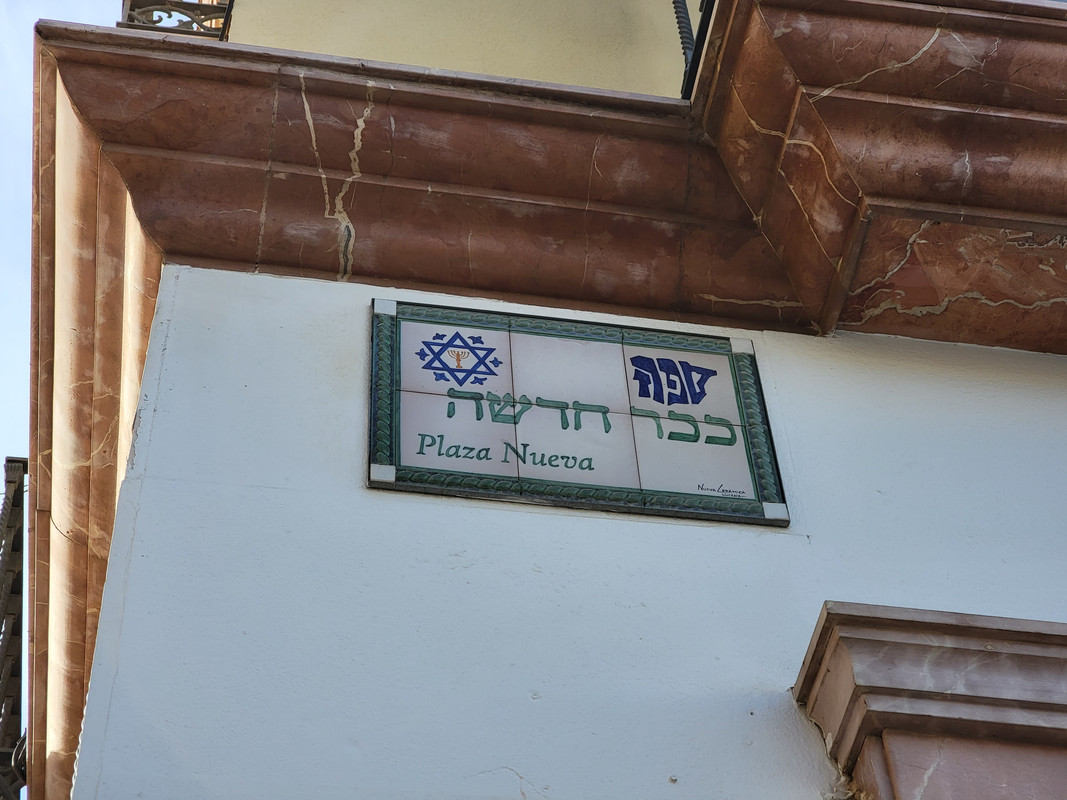
Wednesday dawned sunny with temps in the 50Fs. After a short stroll around town, I noticed that there are virtually no tourists in Lucena- I could also tell by the stares I was getting that I was noticeably out of place. My first stop was to the San Mateo church which I viewed from outside- this housed the old synagogue until 1240.

El Coso Square

My main goal in visiting Lucena was to stop by the Necrópolis Judía- this was Lucena’s Jewish cemetery and was in use from the 8th century til about year 1050. It was rediscovered in 2006 when a new road was being built in the area. This is one of the only Jewish cemeteries in Andalusia from pre-inquisition Spain. I reached out to the tourism board at lucena@tuhistoria.org to schedule a tour- the fee was €35 and can be scheduled on most days between 11AM and 1PM. My guide informed me that she works at the Castillo del Moral/ Archaeological Museum, and that I should meet her there in time for the tour. I decided to stop by the museum a bit earlier to look around the place. There are some interesting Jewish artifacts here, such as headstones recovered from the cemetery, but the signs in English were poorly translated and difficult to read. The entry fee was waived as it is included with the cemetery tour.

Views of Lucena from the Castle’s tower:

Once I was done at the museum my guide and I headed out to the cemetery. It’s on the edge of town, approximately a 15-minute walk from the town’s center.
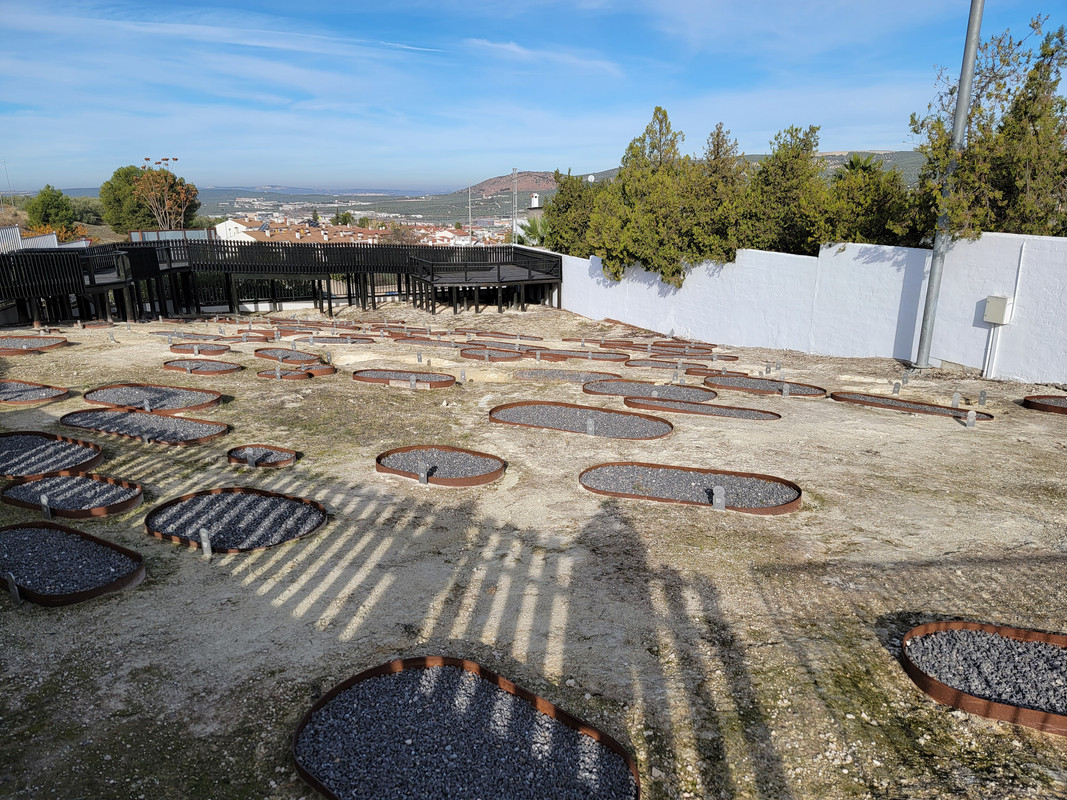
My guide was very knowledgeable about Lucena’s history as well as the details of the cemetery. There are several informational boards at the entrance to the cemetery that provide the history of the place as well. Approximately 400 gravesites were unearthed during the dig, and then reburied on site by organizations in the US and EY.
The cemetery is a lot larger than the currently gated area, but the local government has agreed to suspend further excavations in deference to Jewish law. It is assumed that the entire hill opposite the highway is part of the original cemetery.

I found the experience to be very moving, and my guide gave me some time to say Tehillim. After that she pulled out a Netila cup from her bag so that I could wash my hands prior to exiting the cemetery. She even knew not to take the cup from me until I had placed it on the ground.
I then drove an hour along a beautiful scenic route to El Torcal de Antequera National Park.
El Torcal de AntequeraI had originally hoped to do a longer hike at
El Torcal de Antequera National Park, but I had spent more time than anticipated at the Lucena cemetery, which put me behind schedule. I was debating whether I should skip the park altogether but decided to push in a short 30-minute hike instead of a longer one. Boy, am I glad I didn’t skip this! The drive was spectacular,

and the views in the park are otherworldly! I opted for the green trail, which is a short loop- all trails are signposted and are also programmed on Google Maps. Note that the trails here get slippery after rain, as it is mostly bedrock.
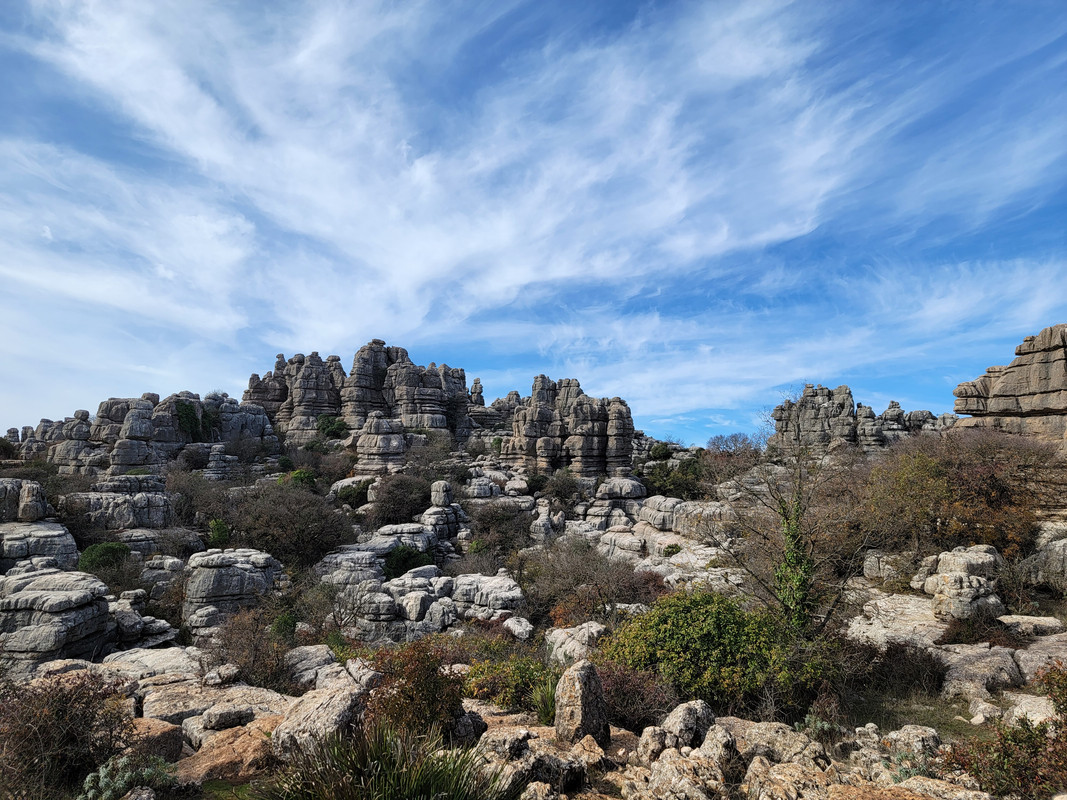
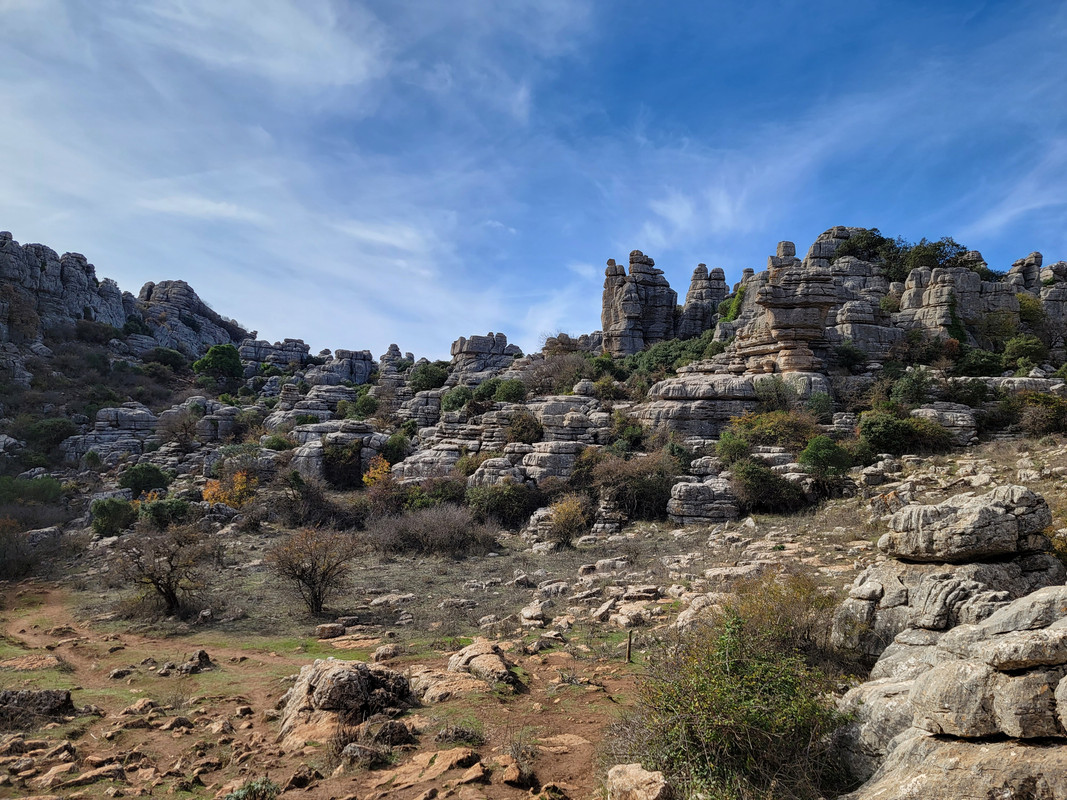
It’s hard to capture just how towering these formations are- can you spot the hiker in the valley?
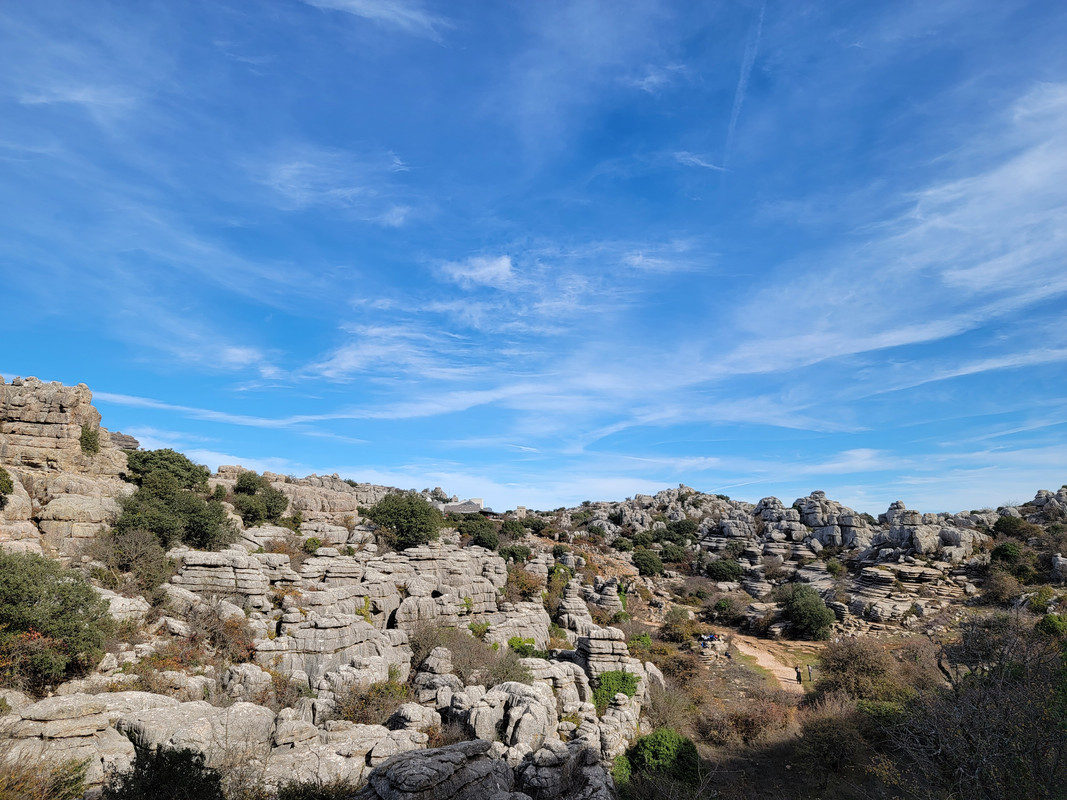
After a quick stop at the visitor’s center, I started the 1-hour drive to Malaga. Google Maps recommends taking a toll road to Malaga from here, but I noticed that the other options that avoid the toll roads don’t take longer, so I opted for a different route. Somewhere along this drive I received a camera speeding ticket- I wasn’t aware that there were speeding cameras on the roads in Spain, but after my trip I received an email from Enterprise that I received a €100 fine for going 109kmh in a 100kmh zone☹. Spain’s DGT offers a 50% discount on fines paid within 20 days- since I didn’t want my driving privileges suspended in case of future trips, I decided to pay the fine within the 20-day grace period to receive the discount. I tried paying the violation via the DGT website several times, but each time I received an error. After digging around on reddit, I saw some users post that the workaround for this is to change the PC’s time zone to Madrid- it worked like a charm! Additionally, Enterprise had informed me that they will be charging a €25 admin fee to get the ticket reissued in my name, but they never ended up charging me for that.
MalagaShlomo ibn Gabirol, who some attribute the composition of "Adon Olam" to, was from Malaga.Since it was wintertime, I was debating whether to stop by Malaga or skip it altogether, but I had a half a day in the region regardless, and since I wasn’t going to be spending Shabbos near a Jewish community I would need to stock up on kosher food beforehand, for which Malaga was the best option. It also turned out to be a good area to redeem my Amex Hilton Aspire resort credit, but more on that later.
My first stop in Malaga was at Plaza de la Merced, to relax a bit and eat lunch. There’s a statue of Shlomo ibn Gabirol here.

I then headed to the Teatro Romano de Málaga- an amphitheater built by the Romans. Entry was free that day, and the interpretation center was interesting.

I then headed directly above the amphitheater to Malaga’s Alcazaba.

I purchased a combo ticket here for the Alcazaba and for the castle that overlooks the city. I used the online audio guide at the Alcazaba. While the Alcazaba is nice, it’s not very grand. I spent about 30 minutes here.

I then walked up to the castle, Castillo de Gibralfaro- note that is a steep 20-minute uphill climb.

The views from up top are great though.
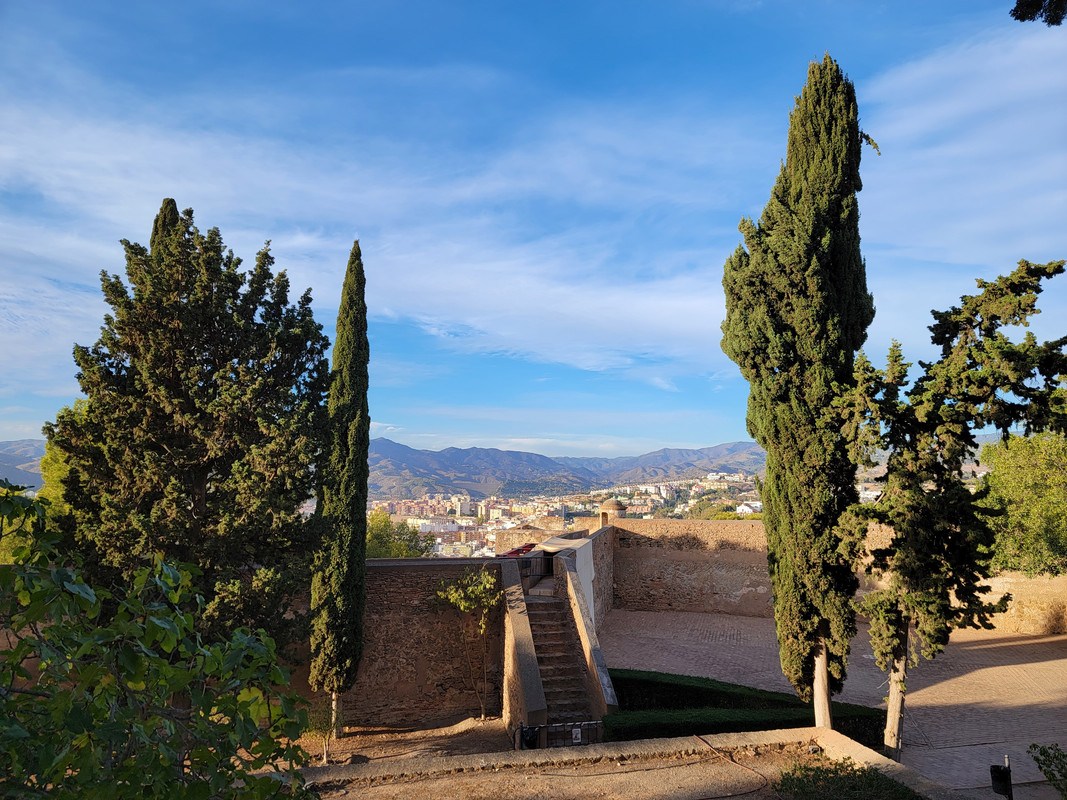
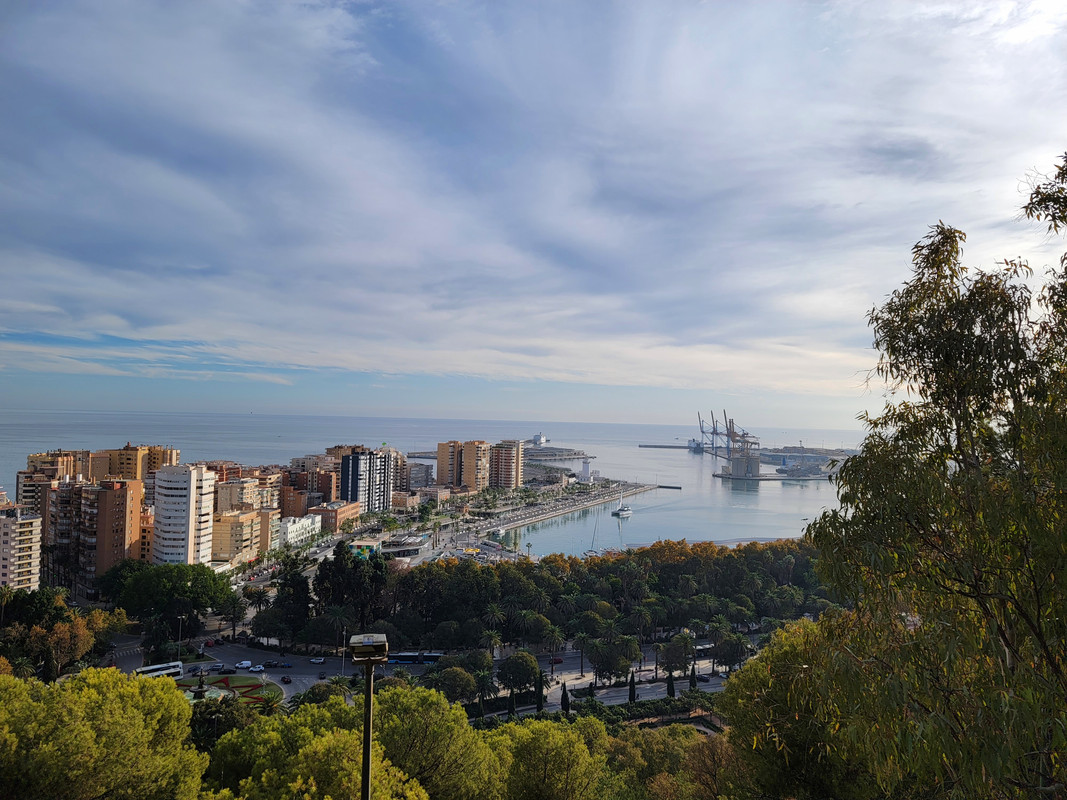
I then headed to Playa de la Misericordia for a few minutes to watch the sunset.
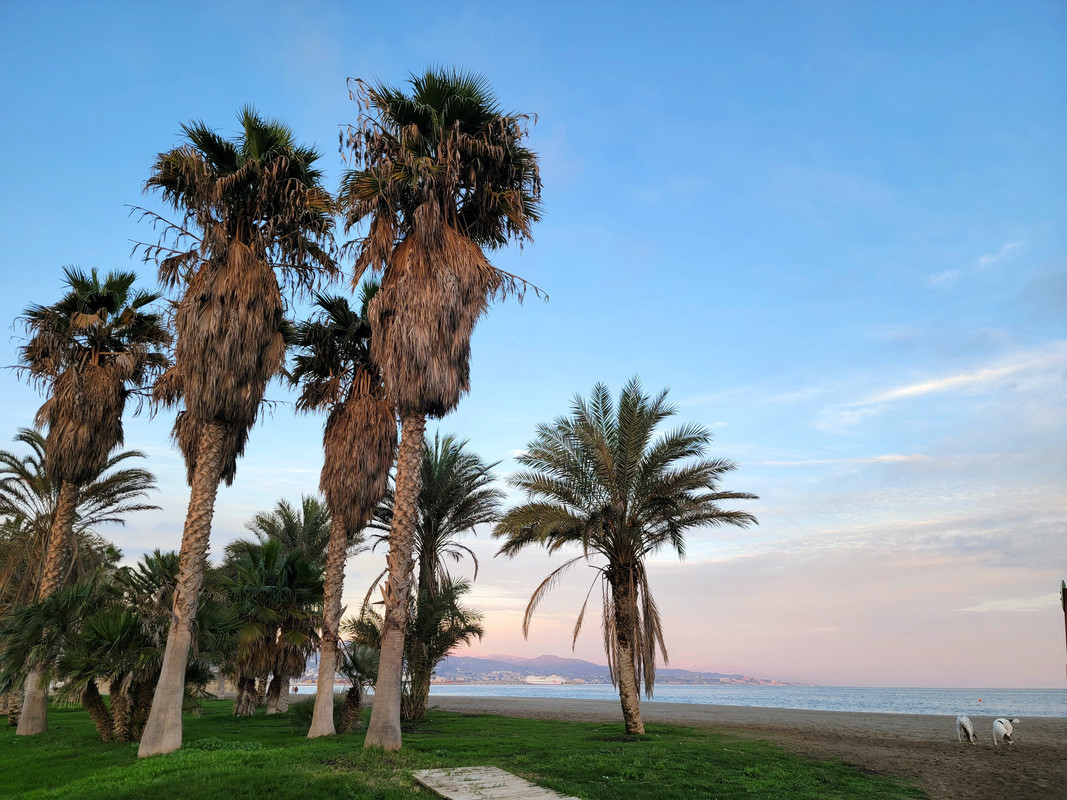
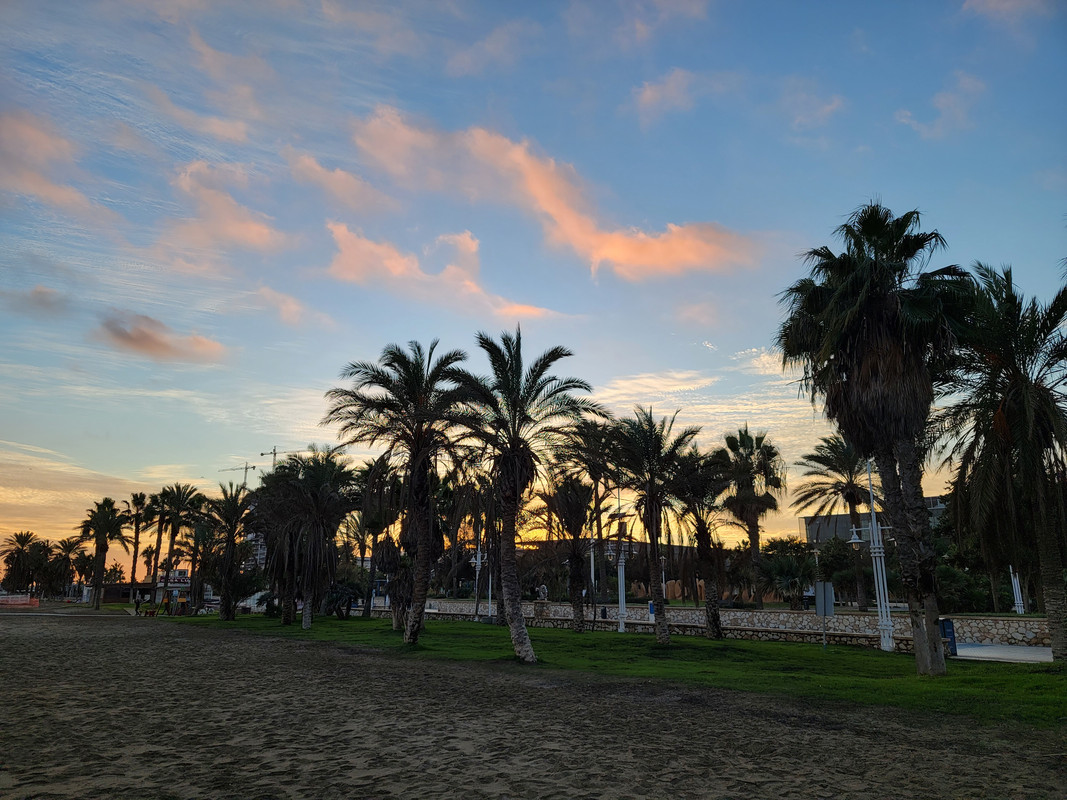
I had reached out to the kosher shop in Torremolinos, [https://koshertorremolinos.com/]CashKash[/URL], in advance via Whatsapp at (+34) 665 17 84 18 to confirm that they would be open that night. The shop carries CY milk as well as some frozen dairy and meat products (I believe it’s sefard shechita) and many shelf stable items, mostly from France and EY. They also have wine and fresh challah and bread. The owner mentioned to me that they have a seasonal restaurant in the summer, and that it would be open in December for Chanukah as well.
After stocking up on food, I headed to the Higueron Hotel Malaga Curio Collection by Hilton for the night, which I had booked with my $250 Amex Hilton Aspire resort credit. Rooms were cheaper than $250 since it was off-season, but it was the end of November and I started worrying that I might not have an opportunity to use the credit before the year’s end, when it expires. In an effort to max out the credit I booked the double points package which after tax came out to $249. With all the various Hilton promotions I ended up getting double nights + double points + 2k bonus points + 1k bonus points on this stay. Checking in was complicated, as the resort is huge and has different entrances for long-term guests, residents, etc. and many of the employees from one area did not know how to navigate to the hotel parking garage. I eventually figured it out and was able to park in the dedicated Diamond area, and then check in immediately at the Diamond desk, where I was given a coupon for two complementary drinks and upgraded to a King Suite with Sea View. I had requested kosher food in advance, which should technically be doable in the area, but they were not forthcoming. The room was spacious with a separate bathroom, shower, and a large bath in the bedroom. The room also had a large terrace with comfortable patio furniture overlooking the grounds, but I wasn’t able to appreciate it fully since it was dark by the time I made it to the hotel, and the next day was my first rainy one in Spain.

Thursday dawned gray and drizzly, but I decided to press on with my schedule in the hopes that it would clear up by the time I made it to my scheduled hike of the day. My first stop was at the Colomares Monument- when originally researching this I had thought it was more of an exhibit dedicated to Columbus’ explorations, but it turned out to be some sort of Instagram photo spot. I was the only person there (probably due to the rain) and I spent a few minutes wandering around disinterestedly.

Next, I headed to Casa de los Navajas. Again, I thought it was something else- I was expecting a mansion of sorts, but it turned out that just two rooms were open for visitors. Entry was free though.

I then started the 1-hour drive to Caminito del Rey, for my scheduled hike.
Caminito del ReyWhen researching the Malaga area, I came across the Caminito del Rey hike. It is touted as one of the must dos in the region and was once considered one of the most dangerous footpaths in the world.
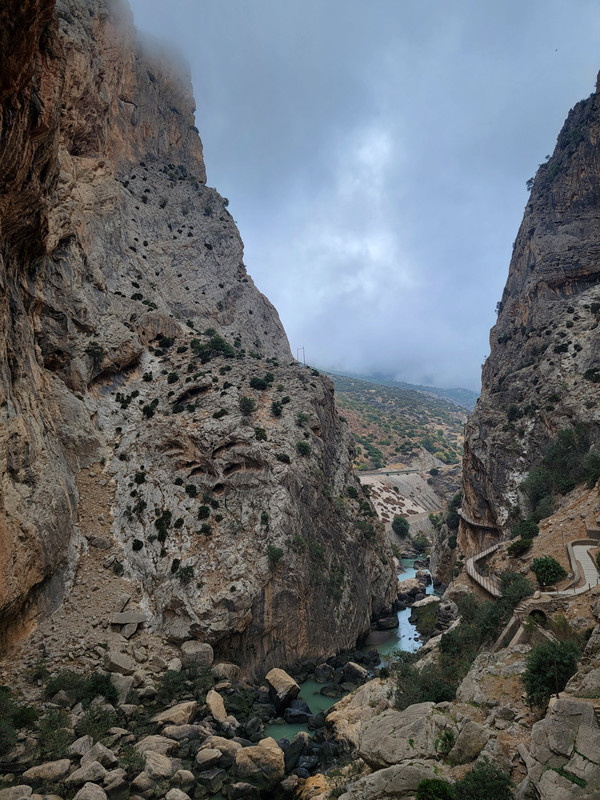
The hike is a one-way 7.7km walk, with about half of it on a narrow footpath along the gorge walls.

There is no parking at the actual entrance, but there are several parking lots further away, with shuttle service running between all lots as well as to the entrance and exit points. Tickets are required to enter the footpath, and the self-guided option sells out quickly (the guided option talks about the area’s geology etc and is not done at your own pace, although I did see people along the way get bored and leave their group), so I had to stretch my schedule a bit with fillers to end up here on Thursday afternoon when there was a self-guided slot available. I reserved parking and the shuttle bus in advance, although those can be paid for on the spot. I arrived at the parking lot about an hour before my scheduled time, but they let me start earlier instead of making me wait for the ticketed time. At the entrance you’re given a helmet and a spiel about safety. There are rangers posted every kilometer or so along the trail to ensure that hikers are proceeding safely. It was foggy and drizzly when I started, and while the weather did not clear up fully, it stopped raining and I got to see patches of blue sky here and there.

The most fun part of the hike for me was at the beginning and towards the end of the trail, which is where the hike is on a narrow footpath high up on the gorge wall.

The middle section is just a forest with no spectacular views. The hike took me about an hour, and is very easy and flat, so I’m not sure why the official website states that it usually takes 3-4 hours.

After the hike there is a popup market of sorts with toilets, food, and souvenir kiosks.
I then started the 1-hour drive to Ronda, where I was to spend the night.
RondaMy drive to Ronda was a challenging one, with fog reducing visibility to almost zero. The town of Ronda is incredibly picturesque, but I’ll hold off on describing it until the fog lifted and I was able to actually see its beauty. Ronda is also popular for its bullfighting history, and there are still several bullfighting events held here each year (bullfighting season is in September).
I checked into Hotel Catalonia Ronda for the night- this location can’t be beat as it is right across the bullfighting museum, and near the beautiful Ronda bridge- the room I was assigned at first had a weird smell, and the front desk was more than happy to assign me to a new room with no fuss, this time with an upgrade that had great views of the bullring.
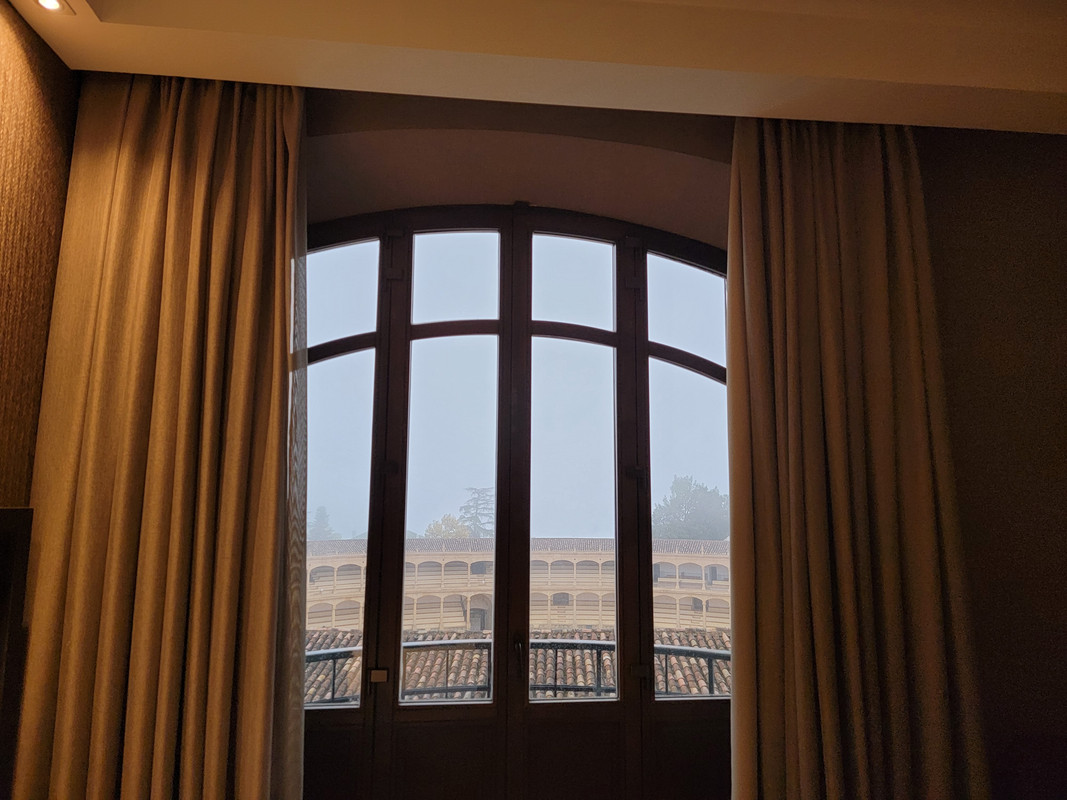
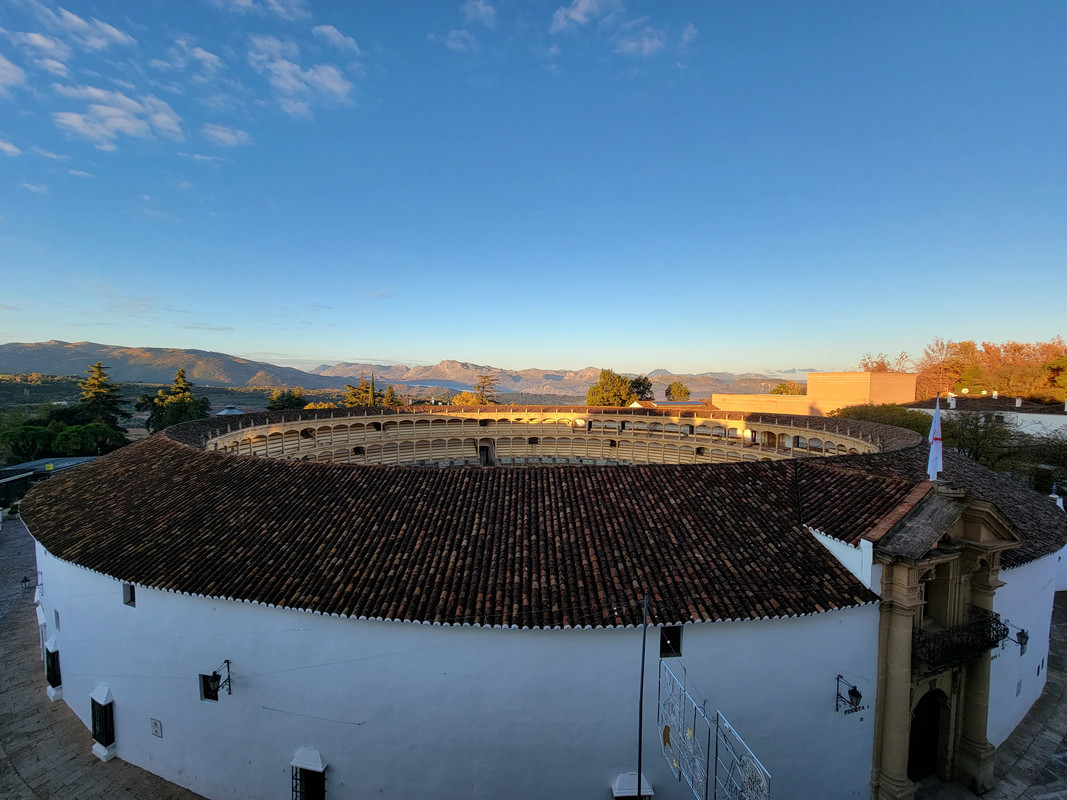
I also received 2 complimentary drinks at the bar for being a member of the hotel chain and parked at their partner garage for discounted parking.
Since I had finished the Caminito del Rey hike earlier than expected, I had time to visit the Bullring of the Royal Cavalry of Ronda. This is the oldest bullring in the world and is one of only five bullrings still in operation. The audio guide here is great, and a must-listen to understand bullfighting culture. There is no mention of humanitarian measures in the museum or the bullring- tradition takes precedence over left-wing posturing here.

Thankfully Friday dawned in the crispy 50Fs and sunny, and I was able to explore Ronda’s beauty. The town of Ronda is perched atop a cliff, with a river running through the town, creating a deep chasm and dividing the two sides. Originally the town was built on just one side, but when the population expanded and more space was needed residents started inhabiting both sides, and the iconic Ronda bridge was constructed.
Mirador De Cuenca
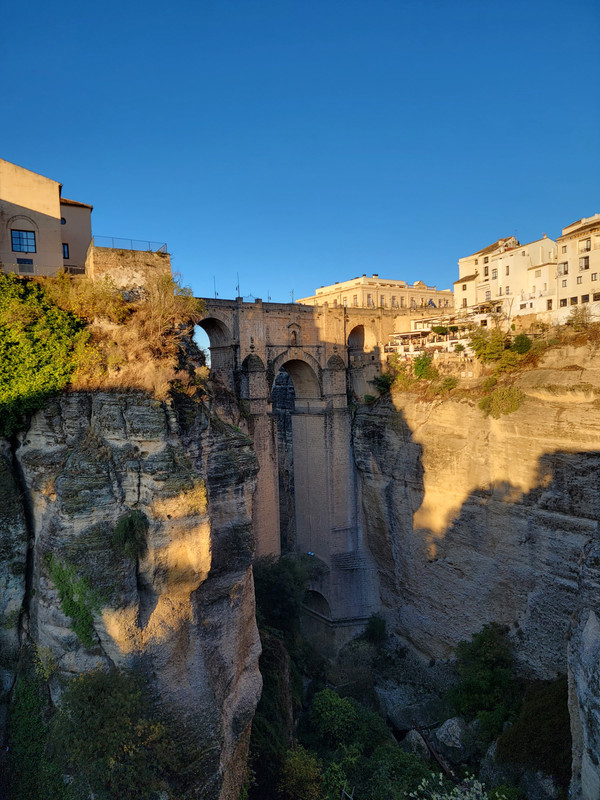
The El Tajo de Ronda lookout

Mirador de Aldehuela

Mirador Puente Nuevo de Ronda

You can see some of the lingering fog rolling through the valley.

After saying goodbye to the amazing views, I headed north for the 2-hour drive to Seville.
SevilleFamed Seville Rishonim: Rabbi Yom Tov ben Avraham (Ritva), and Rabbi David Avudarham.The drive from Ronda to Seville was so beautiful that I didn’t even mind that I was stuck behind a truck on a one-lane road for most of the way. There had been politically motivated attempted bombings in Spain over the previous days, so I had to pass two police checkpoints on my way into the city, but those were uneventful.
The weather was a balmy 60F degrees and sunny on Friday and Shabbos, and while Sunday started out cloudy it quickly cleared up as well. Similar to Córdoba Seville is full of orange trees, but the smell is slightly less inviting, as horse-drawn tourist buggies abound.
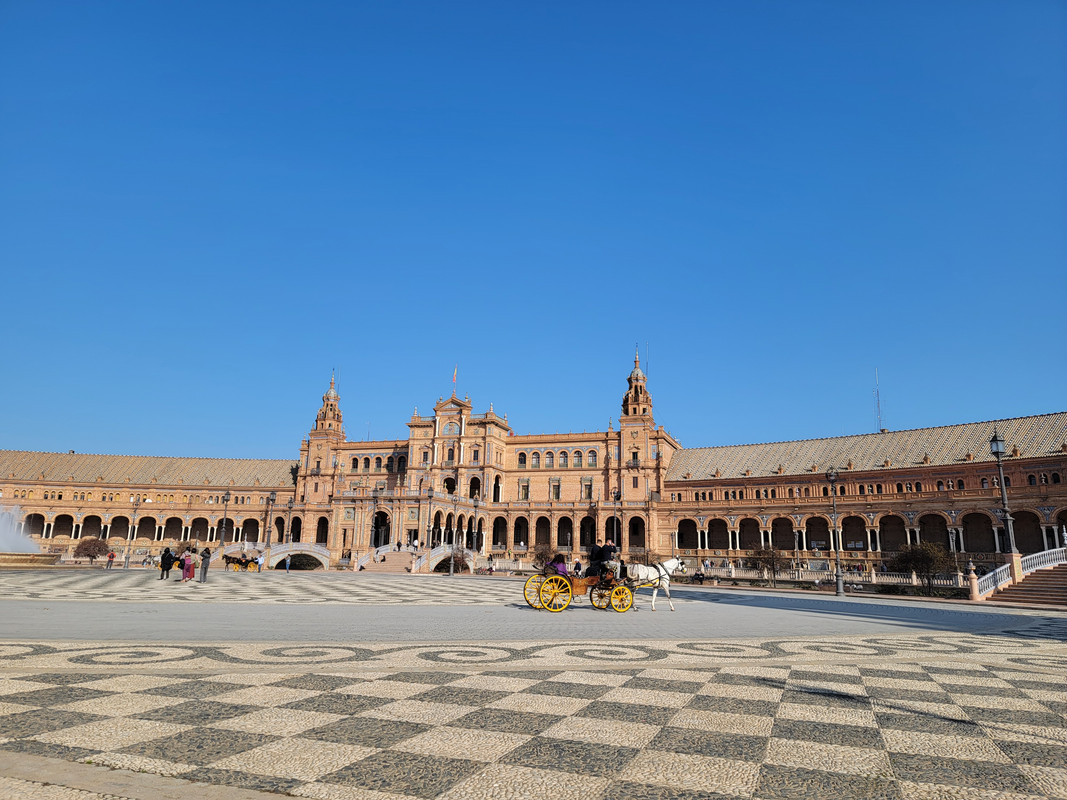
Seville had one of the largest Jewish communities in Spain at the turn of the millennium. The horrific riots of 1391 started in Seville, and approximately 4,000 out its 7,000 Jewish inhabitants were beaten to death. The inquisition was also very active in Seville, with 700 men and women burned at the stake between 1481 and 1488 (prior to the expulsion).
I booked the Meliá Sevilla for my time in Seville. It’s not very centrally located, but it wasn’t too much of a hassle. I requested a low floor in advance so that I wouldn’t have to climb too many steps on Shabbos, and they were able to provide one for me on the second floor. The first room I was assigned had a very strong smoke smell, so I was reassigned to another one on the same floor. After dropping my bags off in my room, I headed out to Enterprise to return my car rental. The drop-off went smoothly, and the attendant was even able to issue a partial refund since I had returned the car with more gas than originally provided.
I then spent some time walking around the city and exploring what was once the Jewish quarter.

The two largest synagogues were turned into churches after the 1391 riots:
Iglesia de San Bartolomé
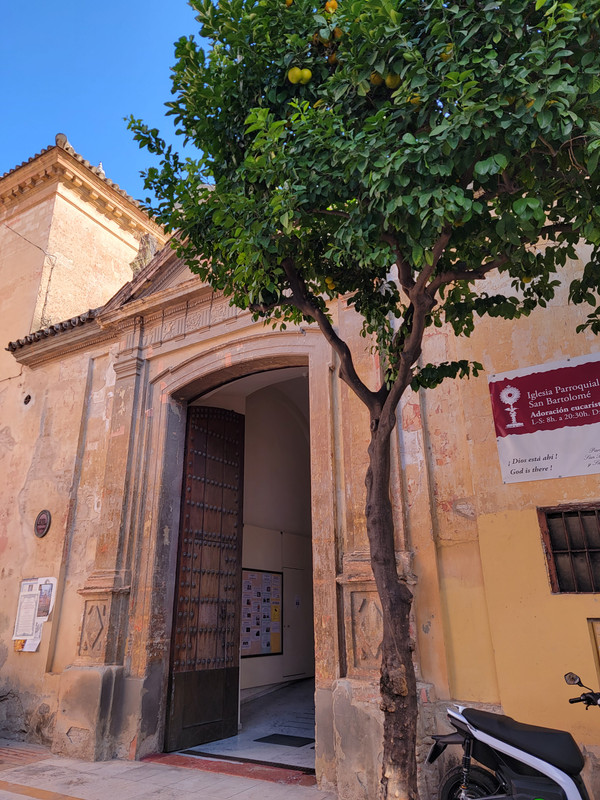
and the Iglesia de Santa María la Blanca
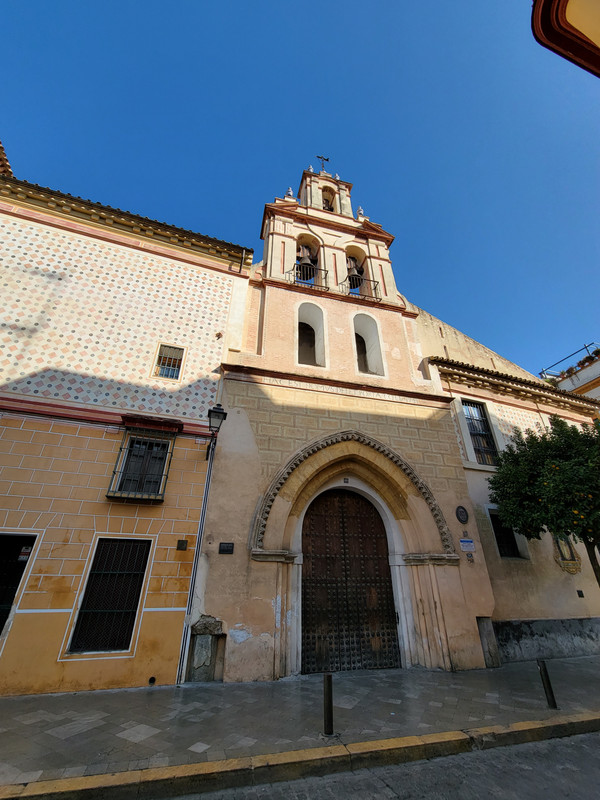
The Seville Cathedral is one of the largest cathedrals in Europe. I didn’t go inside.

Plaza del Triunfo

Puerta de jerez

Plaza de Espana- this is one of the top attractions in Seville, and it is indeed worthy of the crowds. It was originally constructed in 1929 for the Ibero-American Exhibition- today the building houses various museums.
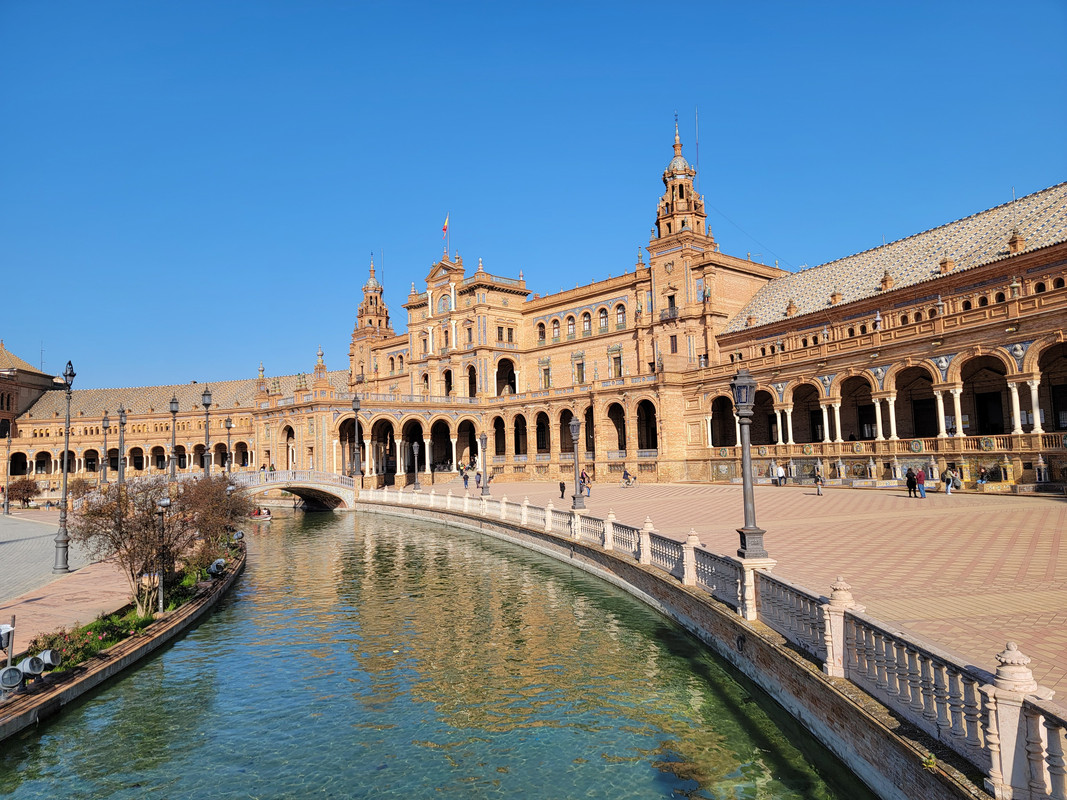
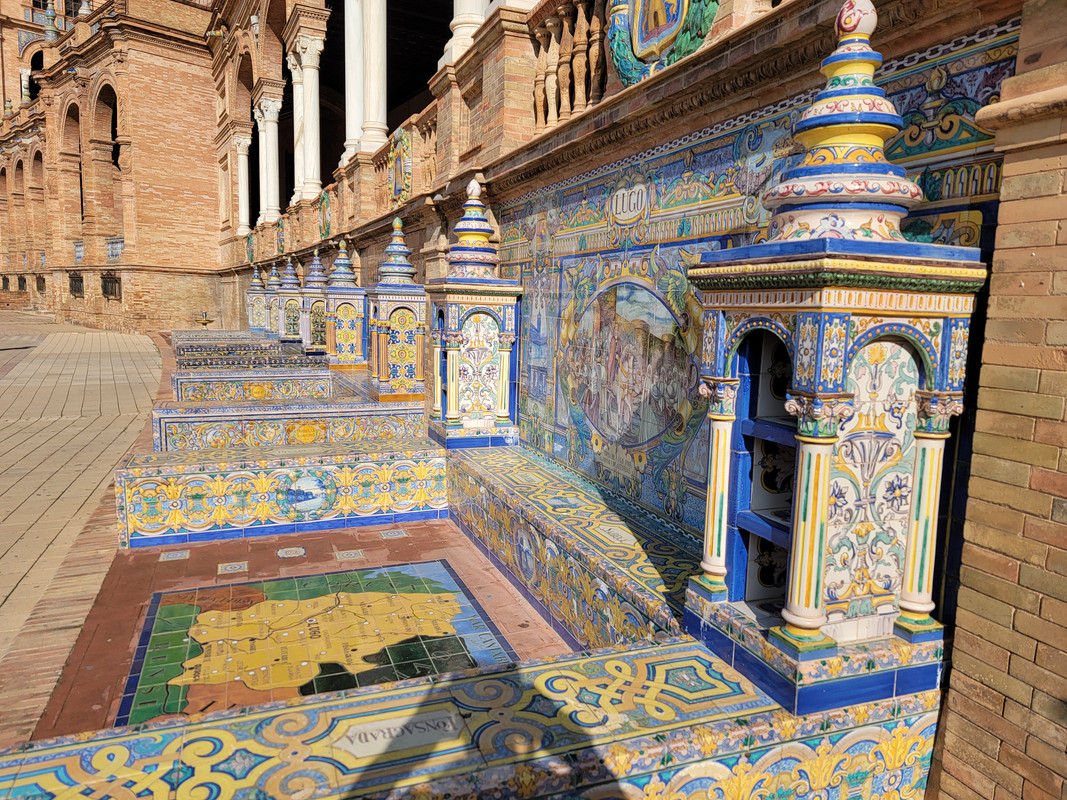
I then headed back to the hotel to prep for Shabbos.
I had done some research on museums in Seville that have free entry on Saturday, and the Military Historical Museum of Seville ended up being my best choice, as it was located not far from my hotel in Plaza Espana and was easy to navigate to. I didn’t end up enjoying the experience- perhaps because it was Shabbos, or perhaps because I don’t love military history. I then spent some time strolling around Plaza Espana and soaking it in.
I had hoped to start my day Sunday at the Centro de Interpretación Judería de Sevilla, but after emailing them at infosefarad@gmail.com I was informed that they were temporarily closed. Instead, I headed to the Royal Alcázar of Seville, where I had reserved a general entry ticket as well as a Royal Apartments tour in advance (this also includes free entry at the Bellver Museum, Antiquarivm, Triana Ceramic Museum and San Jorge Museum, but I did not visit those). At the Puerta del León, which is the entrance to the Alcazar, the line stretched all the way into the square. At intervals different timeslots were announced, so standing in line was fruitless. After a few minutes of waiting, I noticed that my ticket indicated that I must be at the apartments 15 minutes prior to the tour starting, which means that it wouldn’t make sense to wait until my timeslot was announced. I inquired and indeed the announcements were only intended for those with general entry tickets- those with royal apartment tours were able to enter without waiting in line.

The tour of the apartments is 30 minutes, and pictures of the interior are not allowed. The guide’s English was bad, and I was barely able to understand half of it, let alone ask questions. The apartments are nicely decorated, and each room is done in a different style. The upper stories of the Alcázar are still used to this day by the Spanish royal family when they visit Seville. Once I finished my tour of the apartments, I explored the rooms and grounds that are open to all visitors, which were packed.
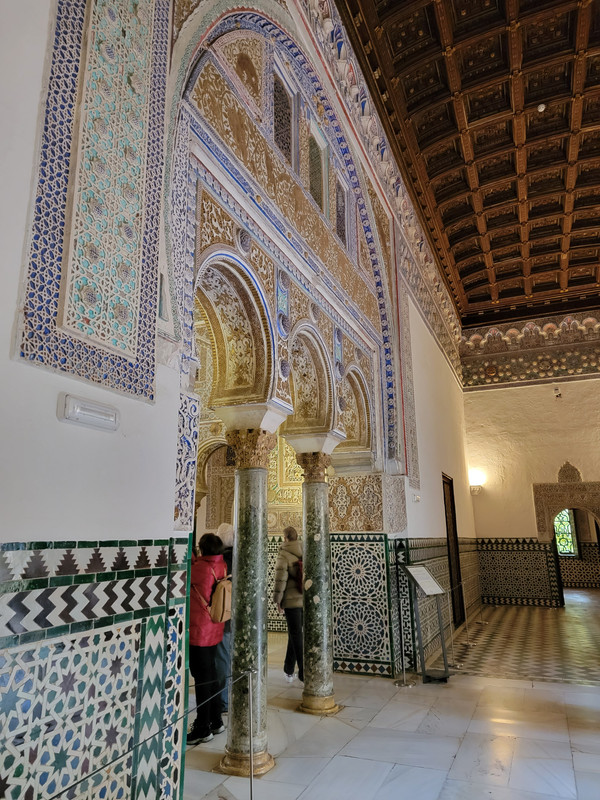

There is an online audio guide available, but it wasn’t very informative. I ended up spending about 1.5 hours at the Alcázar, including the gardens, but would probably have been here longer if not for the crowds.

Torro del Oro

I then visited the Plaza de toros de la Real Maestranza de Caballería de Sevilla, which is Seville’s bullring and museum. I had already visited one in Ronda, but I enjoyed it so much that I decided to do one in Seville as well. The audio guide here is informative but is hosted on Dropbox which makes it a pain to access🙄. The bullring here was a lot fuller than the one in Ronda, and weirdly enough it looks bigger even though the one in Ronda has the biggest rink (although this one has more seats). Bullfights are still held here annually.


I then headed to the Museo Palacio de la Condesa de Lebrija, which is a mansion that was owned by an eccentric old woman that collected all sorts of odd artifacts. There’s a guided tour of the second floor, and I ended up enjoying it more than I thought I would because the guide was funny and informative.

I then stopped by the iconic Mushrooms of Seville.
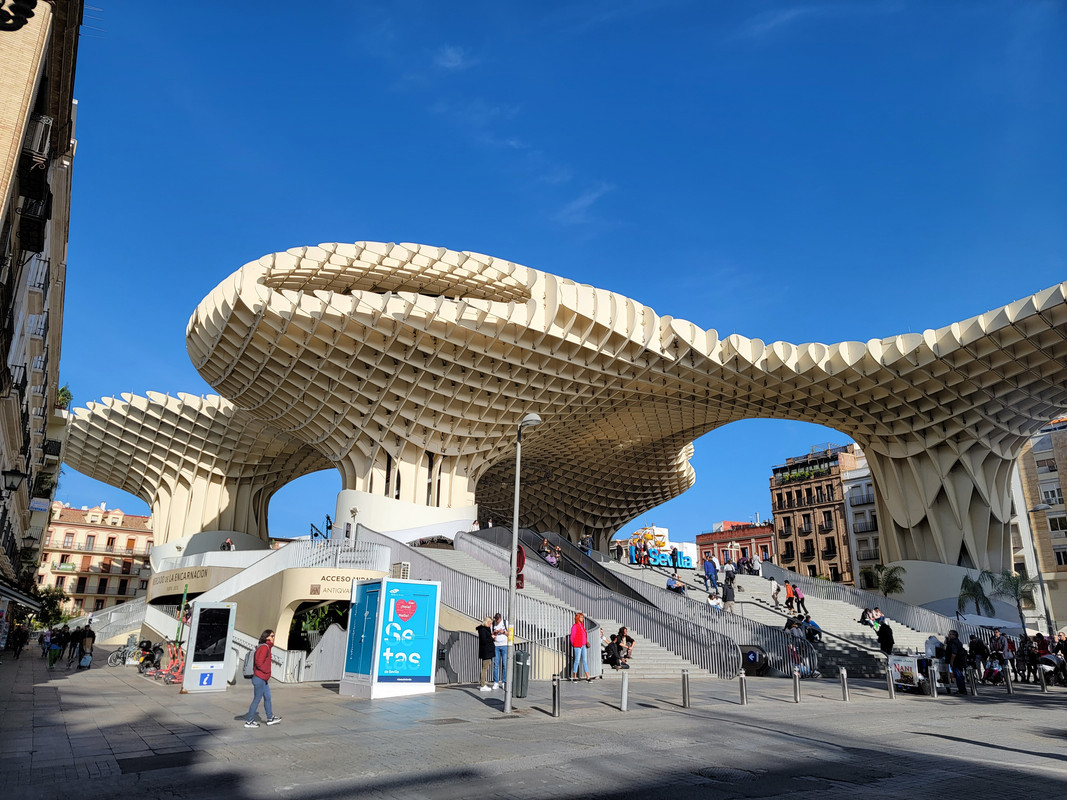
I hadn’t used any public transportation or cabs during my time in Seville, but when trying to figure out the best way from the hotel to the airport, I noticed that Google Maps had a €4 discount when hailing a Cabify through them. It ended up being worth it to take a Cabify rather than public transportation, as the cab wasn’t that much more expensive, and it was a lot less of a hassle.
For this flight I was unable to find one on Air Europa for my desired timing, so I ended up flying with Rynair and prepaying for a carryon bag, for a total of $85. The flight was also more expensive because I did not want to leave Seville before 5PM, to allow for a full day of touring.
After a quick security line (where I once again got looks for not uncovering my hair due to religious reasons), I headed to the Sala VIP Azahar Priority Pass lounge. The lounge is small and was rather crowded. To board there was a short bus ride from the gate to the plane, and then I was off to Tenerife!
 Topic Wiki
Topic Wiki
